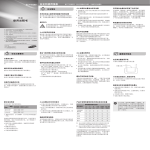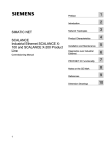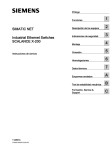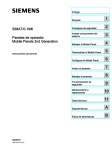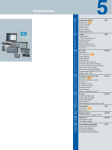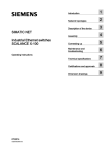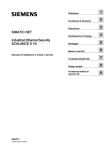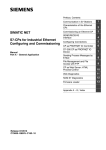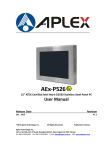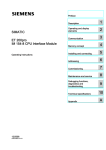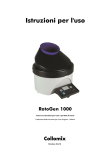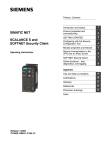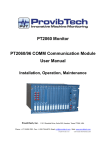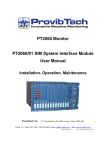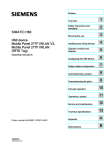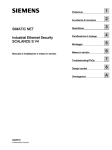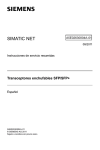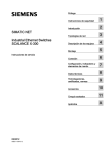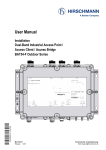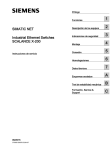Download scalance x204rna scalance x204rna eec - Internet
Transcript
SCALANCE X204RNA SCALANCE X204RNA EEC Operating Instructions Introduction 1 Safety notes 2 Network topologies and redundancy 3 Product characteristics 4 Installation 5 Connection 6 Functional description and configuration using Web based Management 7 Approvals and marking 8 Technical data 9 Accessories and compatible devices 10 References 11 Dimension drawings 12 Legal information Warning notice system This manual contains notices you have to observe in order to ensure your personal safety, as well as to prevent damage to property. The notices referring to your personal safety are highlighted in the manual by a safety alert symbol, notices referring only to property damage have no safety alert symbol. These notices shown below are graded according to the degree of danger. DANGER indicates that death or severe personal injury will result if proper precautions are not taken. WARNING indicates that death or severe personal injury may result if proper precautions are not taken. CAUTION with a safety alert symbol, indicates that minor personal injury can result if proper precautions are not taken. CAUTION without a safety alert symbol, indicates that property damage can result if proper precautions are not taken. NOTICE indicates that an unintended result or situation can occur if the relevant information is not taken into account. If more than one degree of danger is present, the warning notice representing the highest degree of danger will be used. A notice warning of injury to persons with a safety alert symbol may also include a warning relating to property damage. Qualified Personnel The product/system described in this documentation may be operated only by personnel qualified for the specific task in accordance with the relevant documentation, in particular its warning notices and safety instructions. Qualified personnel are those who, based on their training and experience, are capable of identifying risks and avoiding potential hazards when working with these products/systems. Proper use of Siemens products Note the following: WARNING Siemens products may only be used for the applications described in the catalog and in the relevant technical documentation. If products and components from other manufacturers are used, these must be recommended or approved by Siemens. Proper transport, storage, installation, assembly, commissioning, operation and maintenance are required to ensure that the products operate safely and without any problems. The permissible ambient conditions must be complied with. The information in the relevant documentation must be observed. Trademarks All names identified by ® are registered trademarks of Siemens AG. The remaining trademarks in this publication may be trademarks whose use by third parties for their own purposes could violate the rights of the owner. Disclaimer of Liability We have reviewed the contents of this publication to ensure consistency with the hardware and software described. Since variance cannot be precluded entirely, we cannot guarantee full consistency. However, the information in this publication is reviewed regularly and any necessary corrections are included in subsequent editions. Siemens AG Industry Sector Postfach 48 48 90026 NÜRNBERG GERMANY Ⓟ 02/2012 Technical data subject to change Copyright © Siemens AG . All rights reserved Table of contents 1 Introduction................................................................................................................................................ 7 1.1 2 Safety notes............................................................................................................................................... 9 2.1 3 5 6 7 Safety notices.................................................................................................................................9 Network topologies and redundancy........................................................................................................ 13 3.1 4 Introduction ....................................................................................................................................7 Network topology and redundancy ..............................................................................................13 Product characteristics ............................................................................................................................ 15 4.1 Overview of the product characteristics.......................................................................................15 4.2 Components of the product..........................................................................................................17 4.3 Unpacking and checking..............................................................................................................17 4.4 4.4.1 4.4.2 SCALANCE X204RNA.................................................................................................................18 SCALANCE X204RNA product characteristics ...........................................................................18 SCALANCE X204RNA TP interfaces ..........................................................................................19 4.5 4.5.1 4.5.2 4.5.3 SCALANCE X204RNA EEC ........................................................................................................21 SCALANCE X204RNA EEC product characteristics ...................................................................21 SCALANCE X204RNA EEC TP interfaces..................................................................................22 SCALANCE X204RNA EEC SFP interface .................................................................................23 4.6 C-PLUG........................................................................................................................................25 4.7 SET button ...................................................................................................................................27 4.8 4.8.1 4.8.2 4.8.3 4.8.4 Displays........................................................................................................................................29 Fault indicator (yellow/red LED)...................................................................................................29 Power display...............................................................................................................................29 Port status indication....................................................................................................................30 LED displays during startup .........................................................................................................30 Installation ............................................................................................................................................... 31 5.1 Types of installation .....................................................................................................................31 5.2 Din rail mounting ..........................................................................................................................33 5.3 Wall mounting ..............................................................................................................................36 Connection .............................................................................................................................................. 37 6.1 Power supply................................................................................................................................37 6.2 Signaling contact..........................................................................................................................40 6.3 Connecting the SFP transceiver ..................................................................................................41 6.4 Grounding ....................................................................................................................................41 Functional description and configuration using Web based Management ............................................... 43 SCALANCE X204RNA SCALANCE X204RNA EEC Operating Instructions, 3 Table of contents 8 7.1 Introduction ................................................................................................................................. 43 7.2 Prerequisite ................................................................................................................................. 44 7.3 LED simulation of the WBM ........................................................................................................ 46 7.4 Working with the WBM................................................................................................................ 48 7.5 7.5.1 7.5.2 7.5.3 7.5.4 7.5.5 7.5.6 7.5.7 7.5.8 The System menu ....................................................................................................................... 49 System Configuration.................................................................................................................. 49 System Identification & Maintenance.......................................................................................... 50 System Restart & Defaults .......................................................................................................... 51 System Save & Load................................................................................................................... 52 System Version Numbers ........................................................................................................... 55 System Passwords...................................................................................................................... 56 System Select/Set Button ........................................................................................................... 57 System Event Log Table menu................................................................................................... 58 7.6 7.6.1 7.6.2 7.6.3 The X200 menu........................................................................................................................... 60 X200 Status................................................................................................................................. 60 PRP configuration ....................................................................................................................... 62 Fault Mask................................................................................................................................... 63 7.7 7.7.1 7.7.2 7.7.3 7.7.4 7.7.5 7.7.6 7.7.7 The Agent menu.......................................................................................................................... 67 Agent Configuration .................................................................................................................... 67 Agent SNMP Configuration ......................................................................................................... 69 SNMP Trap Configuration ........................................................................................................... 70 Agent Timeout Configuration ...................................................................................................... 72 Agent Event Configuration .......................................................................................................... 73 Agent Syslog Configuration......................................................................................................... 75 Agent Time Configuration ........................................................................................................... 76 7.8 7.8.1 7.8.2 7.8.3 7.8.4 7.8.5 7.8.6 7.8.7 7.8.8 7.8.9 The Switch menu ........................................................................................................................ 78 Introduction ................................................................................................................................. 78 Switch Config .............................................................................................................................. 78 Port status ................................................................................................................................... 79 Switch Forwarding Database ...................................................................................................... 81 the Statistics menu...................................................................................................................... 82 Packet Size Statistic.................................................................................................................... 82 Packet Type Statistic................................................................................................................... 84 Packet Error Statistic................................................................................................................... 86 PRP Statistic ............................................................................................................................... 89 Approvals and marking ............................................................................................................................ 91 8.1 9 Technical data ......................................................................................................................................... 97 9.1 10 11 Approvals and marking ............................................................................................................... 91 Technical specifications .............................................................................................................. 97 Accessories and compatible devices ..................................................................................................... 101 10.1 Accessories ............................................................................................................................... 101 10.2 Compatible devices................................................................................................................... 103 References ............................................................................................................................................ 107 11.1 References ................................................................................................................................ 107 SCALANCE X204RNA SCALANCE X204RNA EEC 4 Operating Instructions, Table of contents 12 Dimension drawings .............................................................................................................................. 109 12.1 Dimension drawings...................................................................................................................109 Glossary ................................................................................................................................................ 113 Index...................................................................................................................................................... 119 SCALANCE X204RNA SCALANCE X204RNA EEC Operating Instructions, 5 Table of contents SCALANCE X204RNA SCALANCE X204RNA EEC 6 Operating Instructions, 1 Introduction 1.1 Introduction Overview of SCALANCE X-200RNA The SCALANCE X-200RNA product family is part of the SCALANCE X product family. Below, you will find a brief overview of this product family. The SCALANCE X family comprises various product lines that complement each other and that are carefully tuned to specific automation tasks. What is possible? The devices of the SCALANCE X-200RNA product line allow the cost-effective setup of Industrial Ethernet structures with Parallel Redundancy Protocol functionality. Purpose of the Operating Instructions These Operating Instructions support you when commissioning networks with the devices of the product line SCALANCE X200RNA. Validity of the Operating Instructions These Operating Instructions are valid for the following devices of the SCALANCE X200RNA product line SIMATIC NET SCALANCE X204RNA 6GK5204-0BA00-2KB2 SIMATIC NET SCALANCE X204RNA EEC 6GK5204-0BS00-3LA3 Names of the devices in these operating instructions The descriptions in these operating instructions always apply to the devices of the SCALANCE X-200RNA product line listed under "Validity of the Operating Instructions" in this document unless the description relates to a specific device of the product line. Further documentation The "SIMATIC NET Industrial Ethernet Twisted Pair and Fiber Optic Networks" manual contains additional information on other SIMATIC NET products that you can operate along with the devices of the SCALANCE X-200 product line in an Industrial Ethernet network. SCALANCE X204RNA SCALANCE X204RNA EEC Operating Instructions, 7 Introduction 1.1 Introduction Finding information To help you to find the information you require more quickly, the manual includes not only the table of contents but also the following sections in the Appendix: ● Index ● Glossary Audience These Operating Instructions are intended for persons commissioning Ethernet networks with the Parallel Redundancy Protocol (PRP). Standards and approvals The devices of the SCALANCE X 200RNA product line meet the requirements for the CE mark. You will find detailed information in the section "Approvals and markings" in these operating instructions. SCALANCE X204RNA SCALANCE X204RNA EEC 8 Operating Instructions, 2 Safety notes 2.1 Safety notices Important notes on using the device Safety notices on the use of the device The following safety notices must be adhered to when setting up and operating the device and during all associated work such as installation, connecting up, replacing devices or opening the device. General notices WARNING Safety extra low voltage The SCALANCE X204RNA is designed for operation with Safety Extra-Low Voltage (SELV) by a Limited Power Source (LPS). (This does not apply to the SCALANCE X204RNA EEC.) This means that only SELV / LPS complying with IEC 60950 1 / EN 60950 1 / VDE 0805 1 must be connected to the power supply terminals. The power supply unit for the equipment power supply must comply with NEC Class 2, as described by the National Electrical Code (r) (ANSI / NFPA 70). If the equipment is connected to a redundant power supply (two separate power supplies), both must meet these requirements. WARNING The maximum current via the terminals is 10 A. You should therefore include a fuse that trips at a current higher than 10 A. The fuse must meet the following requirements: - Suitable for min. 300 VDC / 250 VAC / max. 10 A - Breaking current at least 10 kA - UL/CSA listed (UL 248-1 / CSA 22.2 No. 248-1) As an alternative, the following requirements: - Breaking current at least 10 kA - Approved in compliance with IEC 60127-1 / EN 60127-1 - Breaking characteristics: B or C for a circuit breaker or slow-blow fuse SCALANCE X204RNA SCALANCE X204RNA EEC Operating Instructions, 9 Safety notes 2.1 Safety notices WARNING Opening the device WARNING - EXPLOSION HAZARD DO NOT OPEN WHEN ENERGIZED. General notices on use in hazardous areas WARNING Risk of explosion when connecting or disconnecting the device WARNING – EXPLOSION HAZARD DO NOT CONNECT OR DISCONNECT EQUIPMENT WHEN A FLAMMABLE OR COMBUSTIBLE ATMOSPHERE IS PRESENT. WARNING Replacing components WARNING – EXPLOSION HAZARD SUBSTITUTION OF COMPONENTS MAY IMPAIR SUITABILITY FOR CLASS I, DIVISION 2 OR ZONE 2. WARNING Requirements for the cabinet/enclosure When used in hazardous environments corresponding to Class I, Division 2 or Class I, Zone 2, the device must be installed in a cabinet or a suitable enclosure. General notices on use in hazardous areas according to ATEX (SCALANCE X204RNA only) WARNING Requirements for the cabinet/enclosure To comply with EC Directive 94/9 (ATEX95), this enclosure must meet the requirements of at least IP54 in compliance with EN 60529. WARNING Suitable cables for temperatures in excess of 70 °C If the cable or conduit entry point exceeds 70°C or the branching point of conductors exceeds 80°C special precautions must be taken. SCALANCE X204RNA SCALANCE X204RNA EEC 10 Operating Instructions, Safety notes 2.1 Safety notices WARNING Protection against transient voltage surges Take measures to prevent transient voltage surges of more than 40% of the rated voltage. This is the case if you only operate devices with SELV (safety extra-low voltage). Safety requirements – Installation 100 .. 240 VAC (SCALANCE X204RNA EEC only) Safety requirements for installation According to the IEC 61131-2 standard and therefore in accordance with the EU directive 2006/95/EC (Low Voltage Directive), the devices are "open equipment" and in accordance with UL/CSA certification, they are an "open type". To fulfill requirements for safe operation with regard to mechanical stability, flame retardation, stability, and shock-hazard protection, the following alternative types of installation are specified: ● Installation in a suitable cabinet. ● Installation in a suitable enclosure. ● Installation in a suitably equipped, enclosed control room. SCALANCE X204RNA SCALANCE X204RNA EEC Operating Instructions, 11 Network topologies and redundancy 3.1 3 Network topology and redundancy Parallel Redundancy Protocol The Parallel Redundancy Protocol is a redundancy protocol for Ethernet networks. It is defined in Part 3 of the IEC 624339 standard. The SCALANCE X-200RNA devices support the PRP-1 method. In the remainder of the text, PRP always stands for the PRP-1 protocol. The areas of application of PRP are distributed real-time applications with high reliability demands that depend on the high availability of the network. Compared with classic faulttolerant networks, PRP provides bumpless redundancy. This redundancy procedure allows data communication to be maintained without interruption if there are interruptions in the network. Other redundancy procedures have a reconfiguration time of the network of, for example 200 ms (MRP, 50 nodes in the ring) or 300 ms (HSR, 50 nodes in the ring) and can therefore not be used for substation applications or other applications that require high network availability. The PRP method has the advantage that it uses parallel, separate networks made up of standard network components. The end devices that use this method are connected to the two networks via a preceding device or via two integrated device interfaces. This means that the frame of the end device can be transferred at the same time via both networks. If a transmission path is interrupted, the frame arrives at its destination via the second path. The devices of the SCALANCE X-200RNA family are used to connect end devices without integrated PRP-1 interfaces to parallel networks. Which topologies can be implemented? With the SCALANCE X-200RNA devices, nodes or entire network segments without PRP-1 capability can be connected to a "Parallel Redundancy Protocol" network. The SCALANCE X-200RNA products with their PRP capability can be used to implement an integrated solution for network components and protective devices for a substation and also process application. The SCALANCE X-200RNA can manage a maximum of 1023 MAC addresses. Note Make sure that the maximum permitted cable lengths for the relevant devices are not exceeded. You will find the permitted cable lengths in the technical specifications. SCALANCE X204RNA SCALANCE X204RNA EEC Operating Instructions, 13 Network topologies and redundancy 3.1 Network topology and redundancy Parallel Redundancy Protocol PG/PC/IPC with SOFTNET-IE RNA Server with SOFTNET-IE RNA Industrial Ethernet (LAN A) Industrial Ethernet (LAN B) SIMATIC S7-400 Figure 3-1 SIPROTEC SCALANCE X204RNA PC G_IK10_XX_10333 SCALANCE X204RNA Schematic diagram of the Parallel Redundancy Protocol With the Parallel Redundancy Protocol (PRP), each node must transmit Ethernet frames on two independent, parallel networks. These are two physically separate networks with a bus (linear), star or ring topology. The PRP destination device must also be connected to the two networks. This then receives each frame twice. The first frame is forwarded to the application. The second frame received is recognized and discarded. This achieves N-1 redundancy without reconfiguration (= bumpless switchover). There are already end devices equipped with two Ethernet interfaces that are capable of handling the Parallel Redundancy Protocol (Double Attached Nodes PRP = DANP). On the other hand, there are many end devices starting with S7 controllers right through to control computers that communicate using TCP-IP but do not support PRP and some even have only one Ethernet Interface. With all these devices, a SCALANCE X-200RNA can be connected upstream from them. This allows access for Single Attached Nodes (SAN) to PRP networks. Industrial Ethernet bus (linear), star or ring structures with switching functionality can be implemented cost-effectively with devices of the SCALANCE X product line. You will find a list of usable network components in "Table 10-2 Compatible SCALANCE X devices (oversized frames - 1532 bytes) (Page 103)". SCALANCE X204RNA SCALANCE X204RNA EEC 14 Operating Instructions, 4 Product characteristics 4.1 Overview of the product characteristics Overview of the product characteristics The SCALANCE X204RNA and the SCALANCE X204RNA EEC have the same functionality and differ only in the environmental conditions, the input voltage ranges and the option of using SFP modules with the SCALANCE X204RNA EEC. Table 4- 1 Overview of the product characteristics Device type SCALANCE X204RNA X204RNA EEC SIMATIC environment ● ● Diagnostics LED ● ● 24 VDC ● - 24 V .. 250 VDC / 100 V .. 240 VAC - ● Plastic Metal ● - Housing 2 x 24 VDC 100 Base-T, full duplex/half duplex ●/- ●/- 10 Base-T - - Signaling contact + on-site operation (set/reset button) ● ● Diagnostics: Web, SNMP ● ● C-PLUG (not supported in implementation stage 1) ● ● IRT capability - - SNTP ● ● Note The networks LAN A and/or LAN B can have PROFINET or IRT functionality. These cannot, however, be transferred via the SCALANCE X-200RNA because PRP does not support this. PRP functionality is not impaired by using PROFINET or IRT components in the LAN A and LAN B networks. SCALANCE X204RNA SCALANCE X204RNA EEC Operating Instructions, 15 Product characteristics 4.1 Overview of the product characteristics Table 4- 2 Overview of the connection options Fast Ethernet Device type SCALANCE 100 Mbps X204RNA X204RNA EEC TP (RJ-45) 4 2+2 Fiber multimode (duplex LC) - 2 x SFP modules SFP991-1 multimode glass up to 3 km 6GK59911AD00-8AA0 Fiber single mode (duplex LC) - 2 x SFP modules SFP991-1LD monomode glass up to 26 km 6GK5991-1AF00-8AA0 Fiber single mode (duplex LC) - 2 x SFP modules SFP991-1LH+ monomode glass up to 70 km 6GK5991-1AE00-8AA0 P1, P2 P1, P2 PRP A, PRP B PRP A, PRP B Ports PRP ports Note TP connectors of SCALANCE X204RNA EEC 2 x RJ-45 for connecting two end devices / network structures without PRP-1 capability and optionally 2 x RJ-45 or 2 x SFP modules for connecting network structures capable of PRP. If an SFP module is inserted, the corresponding RJ-45 jack is disabled. Example: If SFP module "PRP A" is inserted, the TP Interface "PRP A" has no function. SCALANCE X204RNA SCALANCE X204RNA EEC 16 Operating Instructions, Product characteristics 4.2 Components of the product 4.2 Components of the product SCALANCE X204RNA The following components are supplied with the SCALANCE X204RNA: ● SCALANCE X204RNA device ● 2-pin plug-in terminal block (signaling contact) ● 4-pin plug-in terminal block (redundant power supply) ● User Manual Compact (BAK) ● CD (Operating Instructions, PST Tool) SCALANCE X204RNA EEC The following components are supplied with the SCALANCE X204RNA EEC: ● SCALANCE X204RNA EEC device ● 3-pin plug-in terminal block (signaling contact) ● 3-pin plug-in terminal block (power supply) ● User Manual Compact (BAK) ● CD (Operating Instructions, PST Tool) ● Bracket for guiding the cable (mechanical protection) 4.3 Unpacking and checking Unpacking, checking 1. Make sure that the package is complete. 2. Check all the parts for transport damage. WARNING Do not use any parts that show evidence of damage! SCALANCE X204RNA SCALANCE X204RNA EEC Operating Instructions, 17 Product characteristics 4.4 SCALANCE X204RNA 4.4 SCALANCE X204RNA 4.4.1 SCALANCE X204RNA product characteristics SCALANCE X204RNA product characteristics Possible attachments The SCALANCE X204RNA has two RJ-45 jacks for connection of end devices or network segments not capable of PRP (P1 and P2) and two RJ-45 jacks for connecting the PRP networks LAN A and LAN B (PRP A and PRP B). Figure 4-1 SCALANCE X204RNA SCALANCE X204RNA SCALANCE X204RNA EEC 18 Operating Instructions, Product characteristics 4.4 SCALANCE X204RNA 4.4.2 SCALANCE X204RNA TP interfaces SCALANCE X204RNA TP interfaces Connector pinout On the SCALANCE X204RNA, the TP interfaces are implemented as RJ-45 jacks with the MDI-X assignment (Medium Dependent Interface Autocrossover) of a network component. Figure 4-2 RJ-45 jack Table 4- 3 Pin assignment Pin number Assignment Pin 8 n. c. Pin 7 n. c. Pin 6 TD- Pin 5 n. c. Pin 4 n. c. Pin 3 TD+ Pin 2 RD- Pin 1 RD+ NOTICE TP cords or TP-XP cords with a maximum length of 10 m can be connected to the RJ-45 TP port. With the IE FC cables and IE FC RJ-45 plug 180, an overall cable length of up to 100 m is permitted between two devices depending on the cable type. Note The interfaces of the SCALANCE X204RNA meet the requirements for environment B according to IEEE 802.3, section 33.4.1.1. SCALANCE X204RNA SCALANCE X204RNA EEC Operating Instructions, 19 Product characteristics 4.4 SCALANCE X204RNA Autonegotiation Autonegotiation means the automatic detection of the functionality of the port at the opposite end. Using autonegotiation, repeaters or end devices can detect the functionality available at the port of a partner device allowing automatic configuration of different types of device. With autonegotiation, two components connected to a link segment can exchange parameters and set themselves to match the supported communication functionality. Note The SCALANCE X204RNA operates permanently in autonegotiation mode and can therefore be connected to other devices that either also use the autonegotiation mode or the 100 Mbps mode FD (full duplex). Note The SCALANCE X204RNA is a plug-and-play device that does not require settings to be made for commissioning. MDI / MDIX autocrossover function The advantage of the MDI / MDIX autocrossover function is that straight-through cables can be used throughout and external Ethernet crossover cables are unnecessary. This prevents malfunctions resulting from mismatching send and receive wires. This makes installation much easier for the user. The SCALANCE X204RNA supports the MDI / MDIX autocrossover function. Note Please note that the direct connection of two ports on the switch or accidental connection over several switches causes an illegal loop. Such a loop can lead to network overload and network failures. Transmission speed The transmission speed of the Fast Ethernet ports is 100 Mbps full duplex. SCALANCE X204RNA SCALANCE X204RNA EEC 20 Operating Instructions, Product characteristics 4.5 SCALANCE X204RNA EEC 4.5 SCALANCE X204RNA EEC 4.5.1 SCALANCE X204RNA EEC product characteristics SCALANCE X204RNA EEC product characteristics Possible attachments The SCALANCE X204RNA EEC has four RJ-45 jacks and two slots for SFP modules. The SFP modules can be used as an alternative to the two RJ-45 jacks PRP A and PRP B and are intended for the connection of the LAN A and LAN B networks. End devices or network segments without PRP capability are connected to the RJ-45 jacks P1 and P2. Figure 4-3 SCALANCE X204RNA EEC SCALANCE X204RNA SCALANCE X204RNA EEC Operating Instructions, 21 Product characteristics 4.5 SCALANCE X204RNA EEC 4.5.2 SCALANCE X204RNA EEC TP interfaces SCALANCE X204RNA EEC TP interfaces Connector pinout On the SCALANCE X204RNA EEC, the TP interfaces are implemented as RJ-45 jacks with the MDI-X assignment (Medium Dependent Interface Autocrossover) of a network component. Figure 4-4 RJ-45 jack Table 4- 4 Pin assignment Pin number Assignment Pin 8 n. c. Pin 7 n. c. Pin 6 TD- Pin 5 n. c. Pin 4 n. c. Pin 3 TD+ Pin 2 RD- Pin 1 RD+ NOTICE TP cords or TP-XP cords with a maximum length of 10 m can be connected to the RJ-45 TP port. With the IE FC cables and IE FC RJ-45 plug 180, an overall cable length of up to 100 m is permitted between two devices depending on the cable type. Note The interfaces of the SCALANCE X204RNA EEC meet the requirements for environment B according to IEEE 802.3, section 33.4.1.1. SCALANCE X204RNA SCALANCE X204RNA EEC 22 Operating Instructions, Product characteristics 4.5 SCALANCE X204RNA EEC Autonegotiation Autonegotiation means the automatic detection of the functionality of the port at the opposite end. Using autonegotiation, repeaters or end devices can detect the functionality available at the port of a partner device allowing automatic configuration of different types of device. With autonegotiation, two components connected to a link segment can exchange parameters and set themselves to match the supported communication functionality. Note The SCALANCE X204RNA EEC operates permanently in autonegotiation mode and can therefore be connected to other devices that either also use the autonegotiation mode or the 100 Mbps mode FD (full duplex). Note The SCALANCE X204RNA EEC is a plug-and-play device that does not require settings to be made for commissioning. MDI / MDIX autocrossover function The advantage of the MDI / MDIX autocrossover function is that straight-through cables can be used throughout and external Ethernet crossover cables are unnecessary. This prevents malfunctions resulting from mismatching send and receive wires. This makes installation much easier for the user. The SCALANCE X204RNA EEC supports the MDI / MDIX autocrossover function. Note Please note that the direct connection of two ports on the switch or accidental connection over several switches causes an illegal loop. Such a loop can lead to network overload and network failures. Transmission speed The transmission speed of the Fast Ethernet ports is 100 Mbps full duplex. 4.5.3 SCALANCE X204RNA EEC SFP interface SCALANCE X204RNA EEC SFP interface The SFF slots are used to insert suitable SFP modules. Here the use of transceivers with an optical interface is particularly practical. SCALANCE X204RNA SCALANCE X204RNA EEC Operating Instructions, 23 Product characteristics 4.5 SCALANCE X204RNA EEC Transmission medium and range Table 4- 5 SFP transceiver - overview SFP transceiver SFP991-1 SFP991-1LD SFP991-1LH+ Transmission medium Multimode FO cable Monomode FO cable Monomode FO cable - Wavelength - Core diameter - Outer diameter 1310 nm 50 or 62.5 µm 125 µm 1310 nm 9 µm 125 µm 1310 nm 9 µm 125 µm Maximum range 3 km 26 km 70 km Order number 6GK5991-1AD00-8AA0 6GK5991-1AF00-8AA0 6GK5991-1AE00-8AA0 Connectors Electrical connection: SFF slot Optical connection: Duplex LC connector Transmission speed The transmission speed of the optical Fast Ethernet ports is 100 Mbps. Transmission technique The transmission mode for 100Base-FX is specified in the IEEE 802.3 standard. SCALANCE X204RNA SCALANCE X204RNA EEC 24 Operating Instructions, Product characteristics 4.6 C-PLUG 4.6 C-PLUG CPLUG (configuration plug) Area of application The C-PLUG is an exchangeable medium for storage of the configuration and project engineering data of the basic device. This means that the configuration data remains available if the basic device is replaced. How it works Power is supplied by the basic device. The C-PLUG retains all data permanently when the power is turned off. If an empty C-PLUG (factory settings) is inserted, all configuration data of the SCALANCE X200RNA is saved to it when the device starts up. Changes to the configuration during operation are also saved on the C-PLUG without any operator intervention being necessary. If a C-PLUG is inserted, the configuration stored internally on the basic device is no longer changed. Al changes made to the configuration during ongoing operation are only stored on the C-PLUG. A basic device with an inserted C-PLUG automatically uses the configuration data of the CPLUG when it starts up. This is, however, only possible when the data was written by a compatible device type. This allows fast and simple replacement of the basic device. If a device needs to be replaced, the C-PLUG is simply taken from the failed component and inserted in the replacement device. The first time it is started up, the replacement device has the same configuration as the failed device except for the MAC address set by the vendor. Compatible devices As a general rule, the data on the C-PLUG is only compatible with devices having an identical order number and the same device name. Over and above this, the data of the SCALANCE X204RNA and the SCALANCE X204RNA is compatible. Using a previously written C-PLUG If you want to insert a C-PLUG that has already been used and has been written to in a SCALANCE X-200RNA with a different configuration, the existing C-PLUG data must first be deleted. Note An IE Switch X-200 normally starts up with the configuration of the C-PLUG, assuming this was written to by a compatible device type. SCALANCE X204RNA SCALANCE X204RNA EEC Operating Instructions, 25 Product characteristics 4.6 C-PLUG Diagnostics Inserting a C-PLUG that does not contain the configuration of a compatible device type, inadvertently removing the C-PLUG, or general malfunctions of the C-PLUG are indicated by the diagnostic mechanisms of the SCALANCE X-200RNA (LEDs, SNMP, WBM, etc.). Inserting in the C-PLUG slot The C-PLUG is not supplied with the SCALANCE X-200RNA. It is available as an optional accessory. The slot for the C-PLUG is located as follows: ●With a SCALANCE X204RNA on the front of the device ●With the SCALANCE X204RNA EEC on the top of the device To insert the C-PLUG, remove the protective cover. The C-PLUG is inserted in the slot. The protective cover must then be closed correctly. NOTICE The C-PLUG may only be inserted or removed when the power is off! Removing the C-PLUG It is only necessary to remove the C-PLUG if a fault occurs on the SCALANCE X-200RNA. The C-PLUG can be removed from the slot using flat pliers, tweezers, or a small screwdriver. If a C-PLUG has been taken out of a device, when the device is restarted, an error message is output in Web Based Management and in the Command Line Interface. In this case, you will need to set the device to operation without C-PLUG. For further information, refer to the section "System C-PLUG WBM menu". SCALANCE X204RNA SCALANCE X204RNA EEC 26 Operating Instructions, Product characteristics 4.7 SET button 4.7 SET button SET button Button function You can change various device settings with the button. Modified settings are retained after device power off/on. The SELECT / SET button is used to switch over the display mode and to make other settings. After turning on the SCALANCE X-200RNA, it is in the display mode. The button has three functions: ● Triggering a device restart ● Reset to the factory defaults. All settings made are overwritten by the factory defaults. ● Define the fault mask and the display at the LEDs. The current states of all ports and the states of the power supplies L1 and L2 are included in the fault mask. The previous fault mask is then overwritten. Different settings are made depending on how long you hold down the button: Figure 4-5 The five button phases Time the button is pressed in seconds Table 4- 6 Phase 1 Button phases Description The currently set fault mask is displayed. If no fault mask has been set, all ports flash one after the other. If you release the button in phase 1, this has no effect. 2 The LEDs of the ports at which there is currently a link flash at 2.5 Hz. If you release the button in phase 2, this has no effect. 3 The LEDs of the ports at which there is currently a link and the LEDs of the connected power supply are lit permanently. If you release the button in phase 3, the fault mask corresponding to the lit LEDs is adopted. 4 All port LEDs flash at 2.5 Hz. Releasing the button during this phase brings about a device restart (soft reset) 5 All port LEDs flash alternately yellow/green at 2.5 Hz. The device is reset to the factory defaults. SCALANCE X204RNA SCALANCE X204RNA EEC Operating Instructions, 27 Product characteristics 4.7 SET button Note On the SCALANCE X204RNA, the button is located below the C-PLUG compartment. On the SCALANCE X204RNA EEC, the button is on the top of the device in a recess next to the C-PLUG compartment. ① ② C-PLUG SET button Figure 4-6 Position of the C-PLUG and SET button SCALANCE X204RNA SCALANCE X204RNA EEC 28 Operating Instructions, Product characteristics 4.8 Displays 4.8 Displays 4.8.1 Fault indicator (yellow/red LED) Fault indicator (yellow/red LED) If the LED is lit red, a SCALANCE X-200RNA has detected an error/fault. At the same time, the signaling contact opens assuming that the response of the signaling contact has not been configured differently. The LED signals that the SCALANCE X-200RNA can adopt the following statuses: Device type SCALANCE LED lit red LED lit yellow LED not lit X204RNA 1, 2, 3, 4, 5 6 7 X204RNA EEC 1, 3, 4, 5 6 7 1. Link down event on a monitored port. 2. Failure of one of the two redundant power supplies. 3. C-PLUG error 4. Device startup, the LED is lit for approx. 20 seconds. 5. Internal error. 6. A redundancy error was detected. 7. No problem has been detected by the SCALANCE X-200RNA. 4.8.2 Power display Power display The LEDs signal the following statuses of the SCALANCE X-200RNA. The status of the power supply is indicated by a green LED: Device type SCALANCE LED lit green LED lit yellow LED not lit X204RNA 1 2 3 X204RNA EEC 4 - 5 1. Both L power supplies are connected (redundant supply). 2. One L power supply is connected (non-redundant supply). 3. Power supply L1 and L2 are not connected or supply voltages are <14 V. SCALANCE X204RNA SCALANCE X204RNA EEC Operating Instructions, 29 Product characteristics 4.8 Displays 4. Power supply L is connected 5. Power supply L is not connected or the supply voltage is too low. 4.8.3 Port status indication Port status indicator (green/yellow LEDs) The LEDs signal the following port statuses of the SCALANCE X-200RNA. The status of interfaces is indicated by two-color LEDs: Device type SCALANCE LED lit green LED lit yellow LED flashes yellow 2 port LEDs 1 2, 3 4 2 PRP port LEDs 1 2, 3 4 2 port LEDs 1 2, 3 4 2 PRP port LEDs 1 2, 3 4 Number of LEDs X204RNA X204RNA EEX 1. TP link exists, no data reception. 2. TP link, data received at TP port. 3. Device startup, the LED is lit for approx. 6 seconds. 4. Setting or display of the fault mask. 4.8.4 LED displays during startup LED displays during startup When a device starts up, the following displays light up in the order shown: 1. Power LEDs (green) light up immediately after turning on the power. 2. Port LEDs go off, the red error LED is lit for approx. 10 seconds. 3. Following startup, the correct link status is indicated by the port LEDs after approximately 5 seconds. 4. The SCALANCE X-200RNA is now ready for operation. SCALANCE X204RNA SCALANCE X204RNA EEC 30 Operating Instructions, 5 Installation 5.1 Types of installation Types of installation The SCALANCE X-200RNA devices can be mounted on a 35 mm DIN rail. Wall mounting is also possible. Note Installation on a SIMATIC S7-300 standard rail is not possible Note When installing and operating the device, keep to the installation instructions and safetyrelated notices in this description and in the SIMATIC NET Industrial Ethernet network manual (Page 107). Unless stated otherwise, the mounting options listed below apply to all SCALANCE X200RNA devices. Note Provide suitable shade to protect the SCALANCE X-200RNA devices against direct sunlight. This avoids unwanted warming of the SCALANCE X-200RNA devices and prevents premature aging of the device and cabling. WARNING If a SCALANCE X204RNA EEC is operated at ambient temperatures between 60 °C and 70 °C, the housing temperature may exceed 70 °C. When installing the X204RNA EEC, select a location where only qualified service personnel or trained users have access to it. Operation of the SCALANCE X204RNA EEC at ambient temperatures of 60 °C - 70 °C is only permitted under these conditions. WARNING If the cable or conduit entry point exceeds 70°C or the branching point of conductors exceeds 80°C special precautions must be taken. SCALANCE X204RNA SCALANCE X204RNA EEC Operating Instructions, 31 Installation 5.1 Types of installation NOTICE Do not cover the ventilation grilles During installation, select a mounting position so that the ventilation grilles are always free to achieve adequate cooling. In the standard position, the ventilation grilles are on the top, bottom and sides (X204RNA EEC only) of the housing. Minimum clearances If you install the SCALANCE X-200RNA in a control cabinet without forced ventilation or cooling, minimum clearances must be maintained to neighboring devices or the wall of the enclosure. By keeping to the minimum clearances, there is then an adequate stream of air for heat dissipation during operation. Keep to the following minimum clearances to neighboring devices. Minimum clearances for installation in control cabinets Minimum clearance to devices below the switch 100 mm Minimum clearance to devices above the switch 100 mm Minimum clearance at the sides (X204RNA EEC) 20 mm SCALANCE X204RNA SCALANCE X204RNA EEC 32 Operating Instructions, Installation 5.2 Din rail mounting 5.2 Din rail mounting Installation Install the SCALANCE X-200RNA on a 35 mm DIN rail complying with DIN EN 60715: 1. Place the upper catch of the device over the top of the DIN rail and then push in the lower part of the device against the rail until it clips into place. 2. Fit the connectors for the power supply. 3. Fit the connectors for the signaling contact. 4. Insert the terminal blocks into the sockets on the device. Figure 5-1 Mounting on the DIN rail based on the example of a SCALANCE X204RNA EEC SCALANCE X204RNA SCALANCE X204RNA EEC Operating Instructions, 33 Installation 5.2 Din rail mounting Fitting the protective bracket ① ② ③ Hang onto rail at top Lock in position below Secure with the screw Figure 5-2 Mounting the protective bracket on the SCALANCE X204RNA EEC SCALANCE X204RNA SCALANCE X204RNA EEC 34 Operating Instructions, Installation 5.2 Din rail mounting Uninstalling Removing a SCALANCE X-200RNA from a DIN rail: 1. First disconnect all connected cables. 2. Use a screwdriver to release the lower rail catch of the device and pull the lower part of the device away from the rail. Figure 5-3 SCALANCE X204RNA removing from a DIN rail (35 mm) SCALANCE X204RNA SCALANCE X204RNA EEC Operating Instructions, 35 Installation 5.3 Wall mounting 5.3 Wall mounting Wall mounting of a SCALANCE X204RNA Preparation for wall mounting Wall mounting 1. For wall mounting, use suitable mounting fittings for the wall (for example, for a concrete wall, two plugs 6 mm diameter and 30 mm long, 2 screws 3.5 mm diameter and 40 mm long). 2. Connect the electrical cable connecting cables. 3. Fit the connectors for the signaling contact. 4. Insert the terminal blocks into the sockets on the SCALANCE X204RNA. For more exact dimensions, please refer to the section "Dimension drawings" (Page 109) in the manual. Note The wall mounting must be capable of supporting at least four times the weight of the SCALANCE X204RNA (see "Technical specifications"). Wall mounting of a SCALANCE X204RNA EEC To mount the SCALANCE X-204RNA EEC on a wall, secure an adequately long piece of DIN rail (35 mm) to the wall. For wall mounting, use suitable mounting fittings for the wall (for example, for a concrete wall, two plugs 6 mm diameter and 30 mm long, 2 screws 3.5 mm diameter and 40 mm long). Now mount the SCALANCE X-204RNA on the DIN rail as described in the section "DIN rail mounting" (Page 33). SCALANCE X204RNA SCALANCE X204RNA EEC 36 Operating Instructions, 6 Connection 6.1 Power supply Power supply The power supply is connected using a 3- or 4-pin plug-in terminal block. Usable cable cross-section 0.25 to 2.5 mm2. The power supply is non-floating. The signal cables of the Ethernet TP ports are floating. Note Removing or inserting the power connector with the power on is not permitted. Table 6- 1 Pin assignment Pin number Pin assignment of the SCALANCE X204RNA Pin assignment of the SCALANCE X204RNA EEC Pin 1 L1 PE Pin 2 M1 L1 L1 Pin 3 M2 N1 Pin 4 L2 +24 VDC +24 VDC +24 V…+250 VDC 100 V … 240 VAC - Note Since the SCALANCE X204RNA EEC does not have a redundant power supply, the power supply must be connected between L1 and N1. SCALANCE X204RNA SCALANCE X204RNA EEC Operating Instructions, 37 Connection 6.1 Power supply WARNING The SCALANCE X204RNA is designed for operation with safety extra-low voltage (SELV). This means that only safety extra-low voltages (SELV) complying with IEC950/EN60950/ VDE0805 can be connected to the power supply terminals. Measures must be taken to prevent transient overvoltages of more than 40% of the rated voltage. This is the case if the devices are operated exclusively with SELV (Safety Extra Low Voltage). The power supply unit for the SCALANCE X204RNA power supply must meet NEC Class 2, as described by the National Electrical Code(r) (ANSI/NFPA 70). The power of all connected power supply units must total the equivalent of a power source with limited power (LPS limited power source). If the device is connected to a redundant power supply (two separate power supplies), both must meet these requirements. The signaling contact can be subjected to a maximum load of 100 mA (safety extra-low voltage (SELV), 24 VDC). Never operate the SCALANCE X204RNA with AC voltage or DC voltage higher than 28.8 V DC. 24 VDC power supply CAUTION If the SCALANCE X204RNA is supplied over long 24 V power supply lines or networks, measures are necessary to prevent interference by strong electromagnetic pulses on the supply lines. These can result, for example, due to lightning or switching of large inductive loads. One of the tests used to attest the immunity of the SCALANCE X204RNA to electromagnetic interference is the "surge immunity test" according to EN61000-4-5. This test requires overvoltage protection for the power supply lines. A suitable device is, for example, the Dehn Blitzductor VT AD 24 V type no. 918 402 or comparable protective element. Vendor: DEHN+SÖHNE GmbH+Co.KG, Hans-Dehn-Str.1, Postfach 1640, D-92306 Neumarkt, Germany. SCALANCE X204RNA SCALANCE X204RNA EEC 38 Operating Instructions, Connection 6.1 Power supply Power supply 100 .. 240 VAC / 24 .. 250 VDC WARNING Danger from line voltage The SCALANCE X204RNA EEC has a power supply of 100 .. 240 VAC or 24 .. 250 VDC. This product can only function correctly and safely if it is transported, stored, set up, and installed correctly, and operated and maintained as recommended. Connecting and disconnecting may only be performed by an electrical specialist. Connect or disconnect power supply cables only when the power is turned off. WARNING The SCALANCE X204RNA EEC does not have an ATEX approval. Devices with 100 to 240 VAC power supply or 24 .. 250 VDC are not approved for use in hazardous areas according to EC-Dir--94/9 (ATEX). CAUTION Securing cables with dangerous voltage Make sure that the connector cannot be released accidentally by pulling on the connecting cable. Lay the cables in cable ducts or cable channels and secure the cables, where necessary, with cable ties. Grounding WARNING PE connection with SCALAMCE X204RNA EEC Grounding simply via the housing is inadequate. For safe operation, the protective ground must be connected to the grounding bolts. On the SCALANCE X204RNA EEC, the PE connector is on the bottom of the device. SCALANCE X204RNA SCALANCE X204RNA EEC Operating Instructions, 39 Connection 6.2 Signaling contact 6.2 Signaling contact Signaling contact The signaling contact (relay contact) is a floating switch with which error/fault states can be signaled by breaking the contact. The signaling contact is connected to a 2- or 3-pin plug-in terminal block. Usable cable cross-section 0.25 to 2.5 mm2. Table 6- 2 Pin assignment Pin number Pin assignment of the SCALANCE X 204RNA Pin assignment of the SCALANCE X 204RNA EEC Pin 1 F1 (NO contact / NC contact if a fault occurs) F1 (NC contact / NO contact if a fault occurs) Pin 2 F2 F2 (pole terminal) Pin 3 - F3 (NO contact / NC contact if a fault occurs) The following errors/faults can be signaled by the signaling contact: ● The loss of a link on a monitored port (see section "Setting the fault mask" (Page 27)). ● The failure of one of the two redundant power supplies (X204RNA only). ● The loss of the entire power supply ● Internal error ● Incompatible C-PLUG was inserted. The connection or disconnection of a communication node on an unmonitored port does not lead to an error message. The signaling contact remains activated until the error/fault is eliminated or until the current status is applied as the new desired status using the button. When the SCALANCE X-200RNA is turned off, the signaling contact is always activated (signals "error/fault"). Note The signaling contact correlates with the red fault LED. Exception: The absence of the power supply is signaled only by the signaling contact (no display by the fault LEDs). SCALANCE X204RNA SCALANCE X204RNA EEC 40 Operating Instructions, Connection 6.3 Connecting the SFP transceiver Note During startup, the signaling contract is always active (signals "error/fault"). 6.3 Connecting the SFP transceiver Connecting the SFP transceiver The SFP modules are supplied with power via the SFF slot of the SCALANCE X204RNA EEC. 6.4 Grounding Grounding SCALANCE X204RNA The housing is made of plastic. There is no need and no possibility of grounding. SCALANCE X204RNA EEC The device is grounded over the DIN rail. There is also a grounding bolt on the underside of the housing. Connect the grounding bolt of the device to the nearest grounding point using the grounding cable. Use minimum conductor size like supply line conductors, but not smaller than 1.5mm²/AWG 16. SCALANCE X204RNA SCALANCE X204RNA EEC Operating Instructions, 41 Connection 6.4 Grounding SCALANCE X204RNA SCALANCE X204RNA EEC 42 Operating Instructions, Functional description and configuration using Web based Management 7.1 7 Introduction Introduction To make the best possible use of the technical possibilities of the SCALANCE X-200RNA devices, you can adapt the configuration of the device to the concrete situation in which it is used. Web Based Management (WBM) accesses the configuration of the SCALANCE X-200RNA using a Web browser. An Ethernet connection to the device is necessary. NOTICE To prevent unauthorized access to the SCALANCE X200RNA, there is an automatic logout after the 15 minutes or after the time configured in the Agent Timeout Configuration menu. A manual logout is also possible with the appropriate button in the user interface. Exiting the browser does does not close the session. If the browser is started again within the timeout, the session continues to be used. Note To use SNMP Management, RMON, and traps, you require a network management station. This does not ship with IE switches. SCALANCE X204RNA SCALANCE X204RNA EEC Operating Instructions, 43 Functional description and configuration using Web based Management 7.2 Prerequisite 7.2 Prerequisite Note The screens described in this section apply to the SCALANCE X200RNA devices. The screens of the SCALANCE X204RNA EEC were chosen to illustrate the examples. Any significant deviations from the screens of the SCALANCE X204RNA are pointed out or shown. Principle of Web Based Management The SCALANCE X200RNA devices have an integrated HTTP server for Web Based Management. If a SCALANCE X-200RNA is addressed using a Web browser, it returns HTML pages to the client computer depending on the user input. The user enters the configuration data in the HTML pages sent by the SCALANCE X200RNA. A SCALANCE X-200RNA evaluates this information and generates reply pages dynamically. The great advantage of this method is that apart from a Web browser, no special software is required on the client. Requirements for Web Based Management ● A SCALANCE X-200RNA must have an IP address before you can use Web Based Management. ● To use Web Based Management, there must be an Ethernet connection between the SCALANCE X-200RNA and the client computer. ● Use of a Microsoft Internet Explorer, version 8 or higher is recommended. ● All the pages of Web Based Management require JavaScript. You should therefore make sure that Java Script is enabled in your browser settings. Note The browser must not be set so that it reloads the page from the server each time the page is accessed. The updating of the dynamic content of the page is ensured by other mechanisms. In the Internet Explorer, you can make the appropriate setting in the Options > Internet Options > General menu in the section Temporary Internet Files with the Settings button. Below the text Check for newer versions of stored pages, the Automatically check box must be selected. ● Web Based Management is HTTP- or HTTPS-based, so you must also enable access to port 80 or 443 if you have a firewall installed. SCALANCE X204RNA SCALANCE X204RNA EEC 44 Operating Instructions, Functional description and configuration using Web based Management 7.2 Prerequisite Starting Web Based Management and logging on 1. Enter the IP address in the address box of the Web browser. If there is a problem-free connection to the SCALANCE X-200RNA, the Logon screen of Web Based Management is displayed: Figure 7-1 Logon dialog 2. In the "User Name" list box, select the "Admin" entry if you want to change settings of the SCALANCE X-200RNA (read and write access). If you select the "User" entry, you only have read access to the configuration data of the SCALANCE X-200RNA. 3. Enter your password. If you have not yet set a password, the default passwords as shipped apply: Enter admin if you selected "admin" as the user name or user if you selected "user". Note For security reasons, make sure that you change the original factory-set passwords. 4. Click the "Log On" button to start the logon. SCALANCE X204RNA SCALANCE X204RNA EEC Operating Instructions, 45 Functional description and configuration using Web based Management 7.3 LED simulation of the WBM 7.3 LED simulation of the WBM Display of the operating state Each SCALANCE X-200RNA has several LEDs that provide information on the operating state of the device. Depending on its location, direct access to the SCALANCE X-200RNA may not always be possible. Web Based Management therefore displays simulated LEDs. The top quarter of the screen shows a schematic representation of the SCALANCE X200RNA with the corresponding LEDs. The meaning of the LED displays is described in the section "Displays" (Page 29) in these Operating Instructions. Figure 7-2 LED simulation of the SCALANCE X204RNA EEC SCALANCE X204RNA SCALANCE X204RNA EEC 46 Operating Instructions, Functional description and configuration using Web based Management 7.3 LED simulation of the WBM Figure 7-3 LED simulation of the SCALANCE X204RNA SCALANCE X204RNA SCALANCE X204RNA EEC Operating Instructions, 47 Functional description and configuration using Web based Management 7.4 Working with the WBM 7.4 Working with the WBM Navigation bar The upper menu bar of WBM contains the following links: ● Console This link is not used here. ● Support When you click this link, you open a SIEMENS AG support page. SIEMENS Support is, however, only accessible when your PC has a connection to the Internet. ● Logout By clicking on this link, you log out from the device. Updating the display with "Refresh" Web Based Management pages have a "Refresh" button at the lower edge of the page. Click this button to request up-to-date information from the IE switch for the current page. Storing entries with "Set Values" Pages in which you can make configuration settings have a "Set Values" button at the lower edge. Click this button to save the configuration data you have entered on the IE switch. Note Changing configuration data is possible only with the "Administrator" login. SCALANCE X204RNA SCALANCE X204RNA EEC 48 Operating Instructions, Functional description and configuration using Web based Management 7.5 The System menu 7.5 The System menu 7.5.1 System Configuration General device information This screen appears if you click the System folder icon: Figure 7-4 System Configuration Current System Time(read-only) The system time is set either by the user or is synchronized by a time-of-day frame (either SINEC H1 time frame or SNTP). You can also see when and how it was set: ● (m) The setting was made manually. ● (p) The setting was made by the Simple Network Time Protocol (SNTP). System Up Time (read-only) The time since the last reboot. Device Type (read-only) The type designation of the device. SCALANCE X204RNA SCALANCE X204RNA EEC Operating Instructions, 49 Functional description and configuration using Web based Management 7.5 The System menu System Contact Enter the name of a contact person responsible for managing the device in this box. System Location In this box, you enter a location for the device, for example a room number. System Name Enter a description of the device in this box. 7.5.2 System Identification & Maintenance System Identification & Maintenance The following screen contains information on device-specific vendor and maintenance data such as the order number, serial number, version numbers etc. Figure 7-5 System Identification & Maintenance I&M 0 Here, you can see the individual parameters for Identification & Maintenance. SCALANCE X204RNA SCALANCE X204RNA EEC 50 Operating Instructions, Functional description and configuration using Web based Management 7.5 The System menu 7.5.3 System Restart & Defaults Resetting the settings In this menu, you will find a button for restarting the SCALANCE X-200RNA as well as options for resetting the settings of the SCALANCE X-200RNA. Figure 7-6 System Restart and Defaults Note Note the following points about restarting a SCALANCE X200RNA: You can only restart the SCALANCE X-200RNA with administrator privileges. A SCALANCE X-200RNA should only be restarted with the buttons of this menu and not by a power cycle on the device. The browser must not be set so that it reloads the page from the server each time the page is accessed. The updating of the dynamic content of the page is ensured by other mechanisms. In the Internet Explorer, you can make the appropriate setting in the Options > Internet Options > General menu in the section Temporary Internet Files with the Settings button. Below the text Check for newer versions of stored pages, the Automatically check box must be selected. SCALANCE X204RNA SCALANCE X204RNA EEC Operating Instructions, 51 Functional description and configuration using Web based Management 7.5 The System menu Restart System Click this button to restart the SCALANCE X-200RNA. You must confirm the restart in a dialog box. During a restart, the SCALANCE X-200RNA is reinitialized, the internal firmware is reloaded, and the device runs a self-test. The learned entries in the address table are deleted. You can leave the browser window open while the SCALANCE X-200RNA restarts. Restore Factory Defaults and Restart Click this button to restore the factory defaults for the configuration. The protected defaults are also reset. An automatic restart is triggered. Note By resetting all the defaults, the IP address is also lost. A SCALANCE X-200RNA can then be accessed using the Primary Setup Tool. 7.5.4 System Save & Load System Save & Load via HTTP The WBM allows you to store configuration information in an external file on your client PC or to load such data from an external file from the PC to the SCALANCE X-200RNA. You can also download both new firmware as well as a new FPGA configuration from suitable files on your client PC. Note Following a firmware update, delete the cache of the Web browser. SCALANCE X204RNA SCALANCE X204RNA EEC 52 Operating Instructions, Functional description and configuration using Web based Management 7.5 The System menu Figure 7-7 System Save & Load via HTTP Configuration File Name and directory path of the configuration file you want to load to the SCALANCE X200RNA. Firmware File Name and directory path of the file from which you want to load the new firmware. FPGA File Name and directory path of the file from which you want to load the FPGA configuration. How to download data using HTTP 1. In the relevant text box, enter a name and directory path for the file from which you want to take the data. 2. Start the download of the relevant file by clicking one of the buttons "Load Configuration and Restart", "Load Firmware and Restart" or "Load FPGA File and Restart". Following the download, there is an automatic restart and the device starts up with the new data. SCALANCE X204RNA SCALANCE X204RNA EEC Operating Instructions, 53 Functional description and configuration using Web based Management 7.5 The System menu How to save data using HTTP 1. Start the save function by clicking either the "Save Configuration" or "Save Private MIB" button. 2. You will be prompted to select a storage location and a name for the file or to accept the proposed file name. Reusing configuration data Saving and reading in configuration data reduces the effort if several SCALANCE X-200RNA devices have the same configuration and when IP addresses are obtained over DHCP. Save the configuration data on your computer after you have configured a SCALANCE X200RNA. Download this file to all other SCALANCE X-200RNA devices you want to configure. If individual settings are necessary for specific devices, these must be made online. The stored configuration data is coded and, as a result, these files cannot be edited with a text editor. SCALANCE X204RNA SCALANCE X204RNA EEC 54 Operating Instructions, Functional description and configuration using Web based Management 7.5 The System menu 7.5.5 System Version Numbers Versions of hardware and software This page shows the versions of the hardware and software with which the SCALANCE X200RNA is being operated: Figure 7-8 System Version Numbers Hardware The version of the firmware is shown here. The hardware version (= product version) it is stored permanently on the SCALANCE X-200RNA. FPGA Version The FPGA version is shown here. Firmware The version of the firmware running on the SCALANCE X-200RNA. FW Build The date on which the firmware running on the SCALANCE X-200RNA was created is displayed here. SCALANCE X204RNA SCALANCE X204RNA EEC Operating Instructions, 55 Functional description and configuration using Web based Management 7.5 The System menu 7.5.6 System Passwords System passwords Note Default for the passwords when supplied Admin password: admin User password: user In this dialog, if you are the administrator, you can change the passwords for Admin and User. The password can be up to a maximum of 16 characters (7-bit ASCII) long. Figure 7-9 System Passwords You apply your settings with Set Values. SCALANCE X204RNA SCALANCE X204RNA EEC 56 Operating Instructions, Functional description and configuration using Web based Management 7.5 The System menu 7.5.7 System Select/Set Button Configuring the Select/Set button On the SCALANCE X-200RNA, the SELECT/SET button is used to ● Change the display mode ● Reset to the factory defaults ● Define the fault mask and the LED display You will find a detailed description of the individual functions available with the button in the section "Set button (Page 27)". On this page, the functionality of the Select/Set button can be restricted or fully disabled. This is possible for the following three functionalities: ● Restore Factory Defaults ● Enable/Disable Reset ● Set Fault Mask Figure 7-10 Select/Set button configuration SCALANCE X204RNA SCALANCE X204RNA EEC Operating Instructions, 57 Functional description and configuration using Web based Management 7.5 The System menu Enable Select/Set Functions You can enable or disable the individual functions of the button by checking or unchecking the relevant box. You apply your settings with Set Values. 7.5.8 System Event Log Table menu Logging events A SCALANCE X-200RNA allows you to log events and to display them on the page of the "Log Table" menu. This, for example, allows you to record when an SNMP authentication attempt failed or when the connection status of a port has changed. You can specify which events are logged in the "Agent Event Configuration" menu item. Figure 7-11 System Event Log Table The "Restart" column indicates the device restart after which the corresponding event occurred. The "Sys.Up Time" column shows the time since the SCALANCE X-200RNA was last restarted in the format HH:MM:SS. Refresh Click on this button to refresh the display. SCALANCE X204RNA SCALANCE X204RNA EEC 58 Operating Instructions, Functional description and configuration using Web based Management 7.5 The System menu Clear With this button, you can delete the content of the log table. SCALANCE X204RNA SCALANCE X204RNA EEC Operating Instructions, 59 Functional description and configuration using Web based Management 7.6 The X200 menu 7.6 The X200 menu 7.6.1 X200 Status Information on the operating status This screen appears if you click the "X200" folder icon. The screen shows information about the power supply and the error status. Figure 7-12 X200 Status Power Line 1 ● Up: Power supply 1 (line 1) is applied. ● Down: Power supply 1 is not applied or is below the permitted voltage. Power Line 2 (SCALANCE X204RNA only, not illustrated) SCALANCE X204RNA SCALANCE X204RNA EEC 60 Operating Instructions, Functional description and configuration using Web based Management 7.6 The X200 menu ● Up: Power supply 2 (line 2) is applied. ● Down: Power supply 2 is not applied or is below the permitted voltage. Fault Status The fault status of the SCALANCE X-200RNA is shown here. The following table contains examples of possible error messages. If more than one problem has occurred, they are listed in the text box one above the other. Error messages Meaning Redundant power line down The redundant power supply has failed. Link down on monitored port The connection to a monitored port is interrupted. No Fault The SCALANCE X-200RNA has not detected a fault (the signaling contact has not responded and the fault LED is not lit). SCALANCE X204RNA SCALANCE X204RNA EEC Operating Instructions, 61 Functional description and configuration using Web based Management 7.6 The X200 menu 7.6.2 PRP configuration PRP configuration The PRP-specific parameters are entered in the PRP Config screen. Figure 7-13 PRP configuration PRP Mode Shows the protocol being used (PRP Mode 1). This value cannot be changed. Duplicate Aging Time The duplicate aging time is entered here. The permitted values are between the 0 and 60,000 ms. The default value is 400 ms. This default value comes from the PRP standard. SCALANCE X204RNA SCALANCE X204RNA EEC 62 Operating Instructions, Functional description and configuration using Web based Management 7.6 The X200 menu 7.6.3 Fault Mask Function of the fault mask With the fault mask, you specify the fault/error states to be monitored by the SCALANCE X200RNA and that will trigger the signaling contact. Possible fault/error states are the absence of the power supply, power supply too low, or an interrupted connection or an unexpected connection established to a partner device. If the signaling contact is triggered, this causes the fault LED on the device to light up and, depending on the configuration of the event table, can trigger a trap or an entry in the log table. Device-related link monitoring of the ports A SCALANCE X-200RNA provides device-related link monitoring. A link-up or link-down also affects the message system if the SCALANCE X-200RNA was appropriately configured. Setting the fault mask on the device Optionally, the fault mask can be set using the SET/SEL button on the SCALANCE X200RNA. For more detailed information, refer to the section "SET button" (Page 27). SCALANCE X204RNA SCALANCE X204RNA EEC Operating Instructions, 63 Functional description and configuration using Web based Management 7.6 The X200 menu Settings in WBM In WBM, you can set the monitoring of the power supply (SCALANCE X204RNA only) and the device-related link monitoring. The settings are made in three separate masks: Figure 7-14 SCALANCE X204RNA Fault Mask Power Monitoring Enable Power Monitoring (SCALANCE X204RNA only) Here, you specify which of the two power supplies of the SCALANCE X204RNA (line 1 and line 2) is monitored. A fault is then indicated by the message system when there is no power on one of the monitored lines (line 1 or line 2) or when the voltage is too low (less than 14 V). (With the SCALANCE X-204RNA EEC, this screen is not displayed). SCALANCE X204RNA SCALANCE X204RNA EEC 64 Operating Instructions, Functional description and configuration using Web based Management 7.6 The X200 menu Figure 7-15 Fault Mask Link Down Monitoring Enable Link Down Monitoring Select the check boxes of the ports whose connection status you want to monitor. If link monitoring is activated, an error is signaled when there is no valid link at this port because, for example, the cable is not plugged in or the connected device is turned off. An error/fault can be signaled in the following ways depending on the configuration of the SCALANCE X-200RNA: Signaling contact, fault LED, SNMP trap, entry in the log table and the syslog. SCALANCE X204RNA SCALANCE X204RNA EEC Operating Instructions, 65 Functional description and configuration using Web based Management 7.6 The X200 menu Figure 7-16 Fault Mask Link Up Monitoring Enable Link Up Monitoring Select the check boxes of the ports whose connection status you want to monitor. If link monitoring is activated, an error is signaled when there is a valid link at this port because, for example, the cable should not be plugged in. An error/fault can be signaled in the following ways depending on the configuration of the SCALANCE X-200RNA: Signaling contact, fault LED, SNMP trap, entry in the log table and the syslog. SCALANCE X204RNA SCALANCE X204RNA EEC 66 Operating Instructions, Functional description and configuration using Web based Management 7.7 The Agent menu 7.7 The Agent menu 7.7.1 Agent Configuration Introduction The "Agent Configuration" screen appears if you click the "Agent" folder icon. This screen provides options for setting the IP address. You can specify whether a SCALANCE X200RNA obtains the IP address dynamically or you can assign a fixed address. IP Address Enter the IP address of the SCALANCE X-200RNA here. Subnet Mask Enter the subnet mask of the SCALANCE X-200RNA here. Note A change to the IP address, the subnet mask or the default gateway becomes active only following a restart of the device. As a result, as soon as one of these three values has changed, a restart is triggered when you press "Set Values". After changing the IP address, to be able to connect to the SCALANCE X-200RNA again, the new address will need to be entered in the WEB browser manually. SCALANCE X204RNA SCALANCE X204RNA EEC Operating Instructions, 67 Functional description and configuration using Web based Management 7.7 The Agent menu Figure 7-17 Agent Configuration Settings for the SCALANCE X-200RNA Syslog Here, you specify whether or not events are sent to a Syslog server. DCP If you select this option, the device can be accessed and configured via DCP (PST Tool and STEP 7). SNTP Enables / disables synchronization of the IE switch system time over an SNTP server in the network. DCP Read Only If you select this option, the configuration data can only be read via DCP (PST Tool and STEP 7). Default gateway If you require the IE switch to communicate with devices (diagnostics stations, e-mail servers, etc.) in a different subnet, you will need to enter the IP address of the default gateway here. SCALANCE X204RNA SCALANCE X204RNA EEC 68 Operating Instructions, Functional description and configuration using Web based Management 7.7 The Agent menu MAC address The MAC address of the SCALANCE X-200RNA. 7.7.2 Agent SNMP Configuration How SNMP works Using SNMP (Simple Network Management Protocol), a Network Management Station can configure and monitor SNMP-compliant nodes, such as a SCALANCE X-200RNA. To allow this, a management agent is installed on the SCALANCE X-200RNA with which the management station exchanges data. There are three frame types: ● Read (management station fetches values from a SCALANCE X-200RNA) ● Write (management station writes values to a SCALANCE X-200RNA) ● Send events to registered nodes (traps). The agent sends messages to registered management stations. Configuration of SNMP with a SCALANCE X-200RNA The "Agent SNMP Configuration" screen appears if you click the "SNMP" folder icon. In the SNMP Configuration screen, you make the basic settings for SNMP. Enable the check boxes according to the SNMP functionality you want to use. For detailed settings (for example traps), there are separate menu items in WBM. SCALANCE X204RNA SCALANCE X204RNA EEC Operating Instructions, 69 Functional description and configuration using Web based Management 7.7 The Agent menu Figure 7-18 Agent SNMP Configuration SNMPv1/v2c Here, you enable / disable SNMPv1/v2c for a SCALANCE X-200RNA. Read Only When this check box is selected, you can only read SNMP variables with SNMPv1/v2c. Traps This enables / disables the sending of SNMPv1/v2c traps. 7.7.3 SNMP Trap Configuration SNMP traps for alarm events If an alarm event occurs, a SCALANCE X-200RNA can send traps (alarm frames) to up to 10 different (network management) stations at the same time. Traps are only sent when events as specified in the Agent Event Configuration menu occur (see Section "Agent Event Configuration" (Page 73)). Note Traps are sent only when the "Traps" option was selected in "SNMP Configuration". SCALANCE X204RNA SCALANCE X204RNA EEC 70 Operating Instructions, Functional description and configuration using Web based Management 7.7 The Agent menu Figure 7-19 SNMPv1 Trap Configuration IP Address Here, you enter the addresses of the stations to which a SCALANCE X-200RNA will send traps. Enable Trap Click on the check box next to the IP addresses to enable the sending of traps to the corresponding stations. SCALANCE X204RNA SCALANCE X204RNA EEC Operating Instructions, 71 Functional description and configuration using Web based Management 7.7 The Agent menu 7.7.4 Agent Timeout Configuration Setting the timeout Here, you can set the times after which there is an automatic logout in WBM. Figure 7-20 Agent Timeout Configuration Web Based Management (sec) Here, you specify the WBM timeout. Permitted values for the WBM timeout: 60-3600 (seconds) 0 means: There is no automatic logout. SCALANCE X204RNA SCALANCE X204RNA EEC 72 Operating Instructions, Functional description and configuration using Web based Management 7.7 The Agent menu 7.7.5 Agent Event Configuration System events of the SCALANCE X-200RNA On this page, you specify how a SCALANCE X-200RNA reacts to system events. By enabling the appropriate check boxes, you specify which events trigger which reactions on the SCALANCE X-200RNA. The following options are available: ● The SCALANCE X-200RNA triggers an SNMP trap. ● The SCALANCE X-200RNA writes an entry in the log file. ● The SCALANCE X-200RNA writes an entry to the Syslog server. Figure 7-21 Agent Event Configuration with the SCALANCE X204RNA EEC SCALANCE X204RNA SCALANCE X204RNA EEC Operating Instructions, 73 Functional description and configuration using Web based Management 7.7 The Agent menu Figure 7-22 Agent Event Configuration with the SCALANCE X204 RNA You can configure the reaction of the SCALANCE X-200RNA to the following events: Cold / Warm Start The SCALANCE X-200RNA was turned on or restarted by the user. Link Change A port has failed or data traffic is being handled again over a port that had previously failed. Authentication Failure There was an SNMP access with a bad password or inadequate access rights. Power Error (SCALANCE X204RNA only) This event occurs only when the power supply line 1 and line 2 are monitored. It indicates that there was a change to line 1 or line 2. Fault State Change The fault status has changed. The fault status can relate to the activated port monitoring, the response of the signaling contact or the power supply monitoring. Redundancy Event There are two situations that are signaled as a redundancy error. 1. If there is a difference in the number of PRP frames received from and A and B. The fault is set. It is reset if the difference in PRP frames received from LAN A and B remains almost the same. 2. If a PRP B frame is received at PRP A or vice versa, the error is set until no more incorrect frames are received for approximately 30 seconds. SCALANCE X204RNA SCALANCE X204RNA EEC 74 Operating Instructions, Functional description and configuration using Web based Management 7.7 The Agent menu 7.7.6 Agent Syslog Configuration Setting the timeout Here, you can set the times after which there is an automatic logout in WBM. Figure 7-23 Agent Syslog Configuration Syslog Server IP Address Enter, the IP address of the Syslog server. Syslog Server Port Enter, the port of the Syslog server. SCALANCE X204RNA SCALANCE X204RNA EEC Operating Instructions, 75 Functional description and configuration using Web based Management 7.7 The Agent menu 7.7.7 Agent Time Configuration Time-of-day synchronization in the network SNTP (Simple Network Time Protocol) is used for synchronizing the time in the network. The appropriate frames are sent by an SNTP server in the network. A SCALANCE X-200RNA logs on as client with this server as recipient of time-of-day frames. Figure 7-24 Agent Time Configuration System Time This box displays the current system time. If no time-of-day synchronization was possible, the box displays "Date/time not set". You can also set the date and time manually, the required input format is MM/DD/YYYY HH:MM:SS. In this case, the text box displays the data and time along with the suffix (m). If the system time was set as a result of synchronization with a server, the suffix is (p). Time Synchronization This box is read-only and shows when the last time-of-day synchronization took place. SNTP Mode The protocol type used is displayed here: ● Poll If you choose this protocol type, you have to define further settings: Time zone offset, Time server, Init poll interval, Poll interval. SCALANCE X204RNA SCALANCE X204RNA EEC 76 Operating Instructions, Functional description and configuration using Web based Management 7.7 The Agent menu SNTP Server IP Address Here, you enter the IP address of the SNTP server whose frames will be used by a SCALANCE X-200RNA to synchronize the time of day. SNTP Server Port Here, enter the port over which the SNTP server is available. Time Zone Select the time zone for the location of the SCALANCE X-200RNA because the SNTP server always sends UTC time. This time is then recalculated and displayed as the local time based on the time zone. There is no standard/daylight-saving time switchover on the SCALANCE X-200RNA. Init poll interval Here, you can enter the interval at which a SCALANCE X-200RNA repeats the initial poll for the system time if this was not successful the first time. Poll interval Once the system time has been adopted the first time from the time server, it is updated cyclically with renewed polls to the time server. Here, you specify how often the updates take place. SCALANCE X204RNA SCALANCE X204RNA EEC Operating Instructions, 77 Functional description and configuration using Web based Management 7.8 The Switch menu 7.8 The Switch menu 7.8.1 Introduction Introduction In this menu, you set the parameters for the switch functionality (assign it to layer 2) of the SCALANCE X-200RNA. This includes the following functions: ● General switch settings such as aging. ● Display of statistical data. 7.8.2 Switch Config Switch functionality The "Switch Configuration" screen appears if you click the "Switch" folder icon. In this screen, you specify the aging time of the SCALANCE X-200RNA. Figure 7-25 Switch Configuration SCALANCE X204RNA SCALANCE X204RNA EEC 78 Operating Instructions, Functional description and configuration using Web based Management 7.8 The Switch menu Aging Enabled A SCALANCE X-200RNA automatically learns the source addresses of the nodes connected to it. This information is used in the SCALANCE X-200RNA to forward data frames to the nodes specifically involved. This reduces the network load for the other nodes. If a SCALANCE X-200RNA does not receive a frame whose source address matches a learnt address within a certain time, it deletes the learnt address. This mechanism is known as aging. Aging prevents frames being forwarded incorrectly, for example when an end device (for example a programming device) is connected to a different switch port. If the check box is not enabled, a SCALANCE X-200RNA does not delete learnt addresses automatically. Aging Time [sec] Here, you enter the time after which the SCALANCE X-200RNA deletes an address if it has not received frames with the corresponding sender address. Here, the aging time can be set as required within the range from 0 to 655 seconds. 7.8.3 Port status Overview of the configuration of the ports The "Port Status" screen appears if you click the "Ports" folder icon. The screen shows the configuration for data transfer for all ports of the SCALANCE X200RNA. SCALANCE X204RNA SCALANCE X204RNA EEC Operating Instructions, 79 Functional description and configuration using Web based Management 7.8 The Switch menu Figure 7-26 Port status The five columns of the table display the following information: Port This shows the port (with the SCALANCE X204RNA also the SFP slot) to which the following information relates. Type Displays the type of port. This information is important because difference modules and therefore different ports can be used in some slots. The following port types are possible: ● TP 100 TX ● FO 100 FX Negotiation Indicates whether or not autonegotiation is enabled. Active Indicates whether or not the port is turned on (true) or turned off (false). Data traffic is possible only over an enabled port. The communications partner of a port that is turned off indicates the connection status "Link Down". Link Status of the link to the network. The following alternatives are possible: ● Up The port has a valid link to the network, a link integrity signal is being received. ● Down The link is down, for example because the connected device is turned off. SCALANCE X204RNA SCALANCE X204RNA EEC 80 Operating Instructions, Functional description and configuration using Web based Management 7.8 The Switch menu 7.8.4 Switch Forwarding Database Display of the Switch Forwarding Database The "Switch Forwarding Database" screen appears if you click the "FDB" folder icon. The screen shows the dynamically learnt MAC addresses in the FDB table for all ports. In addition to this, to allow PRP diagnostics, the screen also shows whether the displayed MAC addresses are listed in the duplicate filter or in the proxy node table. Figure 7-27 Switch Forwarding Database The five columns of the table display the following information: Index Index of the entry Mac Address Learnt MAC address Destination Ports Specifies the destination port via which a frame with the learnt destination MAC address must be output. Duplicate filter Shows whether the MAC address is listed as a source MAC address in the duplicate filter table. SCALANCE X204RNA SCALANCE X204RNA EEC Operating Instructions, 81 Functional description and configuration using Web based Management 7.8 The Switch menu Proxy node Shows whether the MAC address is listed as a source MAC address in the proxy node table. 7.8.5 the Statistics menu Counting and evaluation of received frames A SCALANCE X-204RNA has internal statistics counters with which it counts the number of received frames for each port according to the following criteria: ● Frame length ● Message frame type ● Bad frames This information provides you with an overview of the data traffic and any problems on the network. 7.8.6 Packet Size Statistic Received frames sorted by length The "Packet Size Statistics" page displays how many packets of which size were received at each port. If you click the "Reset Counters" button, you reset the counters for all ports. SCALANCE X204RNA SCALANCE X204RNA EEC 82 Operating Instructions, Functional description and configuration using Web based Management 7.8 The Switch menu Figure 7-28 Packet Size Statistic If you click on an entry in the Port column, the "Packet Size Statistics graphic" is displayed for the selected port. You then see a configurable graphical representation of the counter value. Graphic representation of the statistics This page displays the number of frames received at each port graphically. The display is dependent on the frame length. There is a separate element in the graphic for each of the following ranges: ● 64 bytes ● 65 - 127 bytes ● 128 -255 bytes ● 256 - 511 bytes SCALANCE X204RNA SCALANCE X204RNA EEC Operating Instructions, 83 Functional description and configuration using Web based Management 7.8 The Switch menu ● 512 - 1023 bytes ● 1024 - 1536 bytes Figure 7-29 Packet Size Statistic Graphic With the check box in the "Packet Size" column, you decide the content of the graphic. The value in the "Packets" column in the graphic is only displayed for a certain range if the appropriate check box is selected. The "Percentage" column shows the packets in a certain length range as a percentage of the total packets for this port. When the percentage is calculated, ranges are included only if their check boxes are selected. With the "Previous Port" and "Next Port" buttons, you can change to the display of the previous or next port. 7.8.7 Packet Type Statistic Received frames sorted by type The "Packet Type Statistics" page displays how many frames of the type "unicast", "multicast", and "broadcast" were received and sent at each port. If you click the "Reset Counters" button, you reset the counters for all ports. SCALANCE X204RNA SCALANCE X204RNA EEC 84 Operating Instructions, Functional description and configuration using Web based Management 7.8 The Switch menu Figure 7-30 Packet Type Statistic If you click on an entry in the Port column, the "Packet Type Statistics graphic" is displayed for the selected port. You then see a configurable graphical representation of the counter value. Graphic representation of the statistics This page displays the number of frames received at each port graphically. The display depends on the packet type. There is a separate element in the graphic for each of the following ranges: ● Unicast ● Multicast ● Broadcast SCALANCE X204RNA SCALANCE X204RNA EEC Operating Instructions, 85 Functional description and configuration using Web based Management 7.8 The Switch menu Figure 7-31 Packet Type Statistic Graphic With the check box in the "Packet Type" column, you decide the content of the graphic. The value in the "Packets" column in the graphic is only displayed for a certain packet type if the appropriate check box is selected. The "Percentage" column shows the packets of a certain type as a percentage of the total packets for this port. When the percentage is calculated, packet types are included only if their check boxes are selected. With the "Previous Port" and "Next Port" buttons, you can change to the display of the previous or next port. 7.8.8 Packet Error Statistic Errors in received packets The "Packet Error Statistics" page shows how many bad frames were received per port. The following error types are distinguished: ● Bad Frames Total number of bad received frames. ● CRC Number of frames whose content did not match the CRC checksum. ● Undersize Number of frames with a length less than 64 bytes. SCALANCE X204RNA SCALANCE X204RNA EEC 86 Operating Instructions, Functional description and configuration using Web based Management 7.8 The Switch menu ● Oversize Number of frames with a length greater than 1536 bytes. ● Dropped L2 Number of frames that were discarded at the receiving port due to lack of resources on the switch. If you click the "Reset Counters" button, you reset the counters for all ports. Figure 7-32 Packet Error Statistic If you click on an entry in the "Port" column, the "Packet Error Statistics graphic" is displayed for the selected port. You then see a configurable graphical representation of the counter value. Graphic representation of the statistics This page displays the number of bad frames graphically. The display is dependent on the cause of the error. There is a separate element in the graphic for each of the following causes of error: ● Bad Frames ● CRC ● Undersize SCALANCE X204RNA SCALANCE X204RNA EEC Operating Instructions, 87 Functional description and configuration using Web based Management 7.8 The Switch menu ● Oversize ● Dropped L2 Figure 7-33 Packet Error Statistic Graphic With the check box in the "Packet Error" column, you decide the content of the graphic. The value in the "Packets" column in the graphic is only displayed for a certain packet type if the appropriate check box is selected. The "Percentage" column shows the errors of a certain type as a percentage of the total errors for this port. When the percentage is calculated, error types are included only if their check boxes are selected. With the "Previous Port" and "Next Port" buttons, you can change to the display of the previous or next port. SCALANCE X204RNA SCALANCE X204RNA EEC 88 Operating Instructions, Functional description and configuration using Web based Management 7.8 The Switch menu 7.8.9 PRP Statistic PRP Statistic The "PRP Statistic" page shows interesting statistical data for the PRP protocol. The following events are distinguished: ● Received "A Frames" at PRP A Port Number of valid A frames received at port PRP A. ● Received "B Frames" at PRP B Port Number of valid B frames received at port PRP B. ● Received "B Frames" at PRP A Port Number of valid B frames received at port PRP A (error). ● Received "A Frames" at PRP B Port Number of valid A frames received at port PRP B (error). If you click the "Reset Counters" button, you reset the counters for all ports. Figure 7-34 PRP Statistic SCALANCE X204RNA SCALANCE X204RNA EEC Operating Instructions, 89 8 Approvals and marking 8.1 Approvals and marking Approvals and marking Note The specified approvals apply only when the corresponding mark is printed on the product. You can check which of the following approvals have been granted for your product by the markings on the type plate. Product name Type designation Order number SCALANCE X204RNA 6GK5204-0BA00-2KB2 SCALANCE X204RNA EEC 6GK5204-0BS00-3LA3 EC directives SIMATIC NET products meet the requirements and aims of the following EC directives. Conformity certificates You will find the EC Declaration of Conformity for this product on the Internet at the following address: (http://support.automation.siemens.com/WW/view/de/52323714/133400) → Entry list → Entry type "Certificates" → Type of certificate "Declaration of conformity" Example German: "EG Konformitätserklärung SCALANCE X204RNA", Example English: "Declaration of Conformity SCALANCE X204RNA ". EMC directive (electromagnetic compatibility) The SCALANCE X-200RNA devices meet the requirements of the EC directive: 2004/108/EEC "Electromagnetic Compatibility" SCALANCE X204RNA SCALANCE X204RNA EEC Operating Instructions, 91 Approvals and marking 8.1 Approvals and marking The product is designed for use in the following areas: Area of application Industry RF interference level Immunity to interference EN 61000 6 4: 2007 EN 61000 6 2: 2005 WARNING Personal injury and damage to property may occur. The installation of expansions that are not approved for SIMATIC NET products or their target systems may violate the requirements and regulations for safety and electromagnetic compatibility. Only use expansions that are approved for the system. ● Keep to the installation guidelines The product meets the requirements if you adhere to the installation and safety instructions contained in this documentation and in the following documentation when installing and operating the product. ● You can always find the latest documentation on the Internet! The current descriptions of the currently available products can always be found on the Internet under the specified Internet pages: – SIMATIC NET Industrial Twisted Pair and Fiber Optic Networks (http://support.automation.siemens.com/WW/view/en/8763736/) , Manual – EMC Installation Guideline (http://support.automation.siemens.com/WW/view/en/28518276) , Configuration manual ● Working on the product To protect the product from electrostatic discharge, personnel must first discharge any electrostatic charge from their body before touching the product. Note The product was tested with a device that also complies with the standards listed above. When operating the product with a device that does not comply with these standards, adherence to the corresponding values cannot be guaranteed. Explosion protection directive (ATEX) The SCALANCE X204RNA device meets the requirements of the EC directive: SCALANCE X204RNA SCALANCE X204RNA EEC 92 Operating Instructions, Approvals and marking 8.1 Approvals and marking 94/9/EC (ATEX95) "Equipment and protective systems intended for use in potentially explosive atmospheres" Note When using (installing) the SCALANCE X204RNA in hazardous area zone 2, make absolutely sure that the associated conditions are adhered to. You will find these conditions on the SIMATIC NET Manual Collection. ● "Approval of SIMATIC/ SIMATIC NET Products for Direct Installation in Ex-Zone 2" ATEX code: II 3 G Ex nA II T4 KEMA 07 ATEX 0145X The product meets the requirements of the standards ● EN 60079-15 (electrical apparatus for potentially explosive atmospheres; Type of protection "n") ● and EN 60079-0 FM approval The SCALANCE X204RNA meets the requirements of the standards: ● Factory Mutual Approval Standard Class Number 3611 ● FM Hazardous (Classified) Location Electrical Equipment: Non Incendive / Class I / Division 2 / Groups A,B,C,D / T4 A and Non Incendive / Class I / Zone 2 / Group IIC / T4 FDA and IEC approvals The following products meet the FDA and IEC requirements listed below. ● SFP module SFP991-1LD ● SFP module SFP991-1LH+ Figure 8-1 FDA and IEC approvals Notice for Australia (C-Tick) The product meets the requirements of the AS/NZS 2064 standard (Class A). SCALANCE X204RNA SCALANCE X204RNA EEC Operating Instructions, 93 Approvals and marking 8.1 Approvals and marking Notice for Korea (Kc) The product meets the requirements of the Korea Certification. UL Approval for Information Technology Equipment Underwriters Laboratories (UL) complying with Standard UL 60950-1 UL Approval for Industrial Control Equipment Underwriters Laboratories (UL) complying with Standard UL 508 CSA Approval for Information Technology Equipment CSA Certification Mark Canadian Standard Association CSA C22.2 No. 60950-1-03 CSA Approval for Industrial Control Equipment CSA Certification Mark Canadian Standard Association CSA C22.2 No. 142-M1987 cULus Approval for Information Technology Equipment Underwriters Laboratories Inc. complying with ● UL 60950-1 (Information Technology Equipment) ● CSA C22.2 No. 60950-1-03 cULus Approval for Industrial Control Equipment Underwriters Laboratories Inc. complying with ● UL 508 ● CSA C22.2 No. 142-M1987 SCALANCE X204RNA SCALANCE X204RNA EEC 94 Operating Instructions, Approvals and marking 8.1 Approvals and marking Table 8- 1 Certifications and approvals Device type SCALANCE cULus FM CE X204RNA EN 61000-6-4, UL 60950 FM 3611 1 EN 61000-6-2 CL.1, Div.2 CSA GP. A.B.C.D C22.2 No. T.. 60950 1 CL.1, Zone 2, C-Tick Kc AS/NZS Korea 2064 (Class Certification A). ATEX95 Zone 2 E1 EN 60079-15, EN 60079-0 - II 3 G Ex nA II T.. KEMA 07 ATEX 0145X GP. IIC, T.. Ta:.. X204RNA EEC UL 508 - EN 61000-6-4, CSA C22.2 EN 61000-6-2 AS/NZS Korea 2064 (Class Certification A). - - No. 142M1987 FM-/ATEX approval: For temperature information "T.." or the maximum ambient temperature "Ta:..", refer to the type plate. Table 8- 2 Mechanical stability Device type SCALANCE X204RNA IEC 60068-2-6 vibration IEC 60068-2-27 shock 5 – 9 Hz: 3.5 mm 15 g , 6 ms duration 9 – 500 Hz: 1g 6 shocks per axis 1 octave/min, 20 sweeps X204RNA EEC 5 – 9 Hz: 3.5 mm 15 g, 11 ms duration 9 – 150 Hz: 1 g 6 shocks per axis 10 cycles per axis SCALANCE X204RNA SCALANCE X204RNA EEC Operating Instructions, 95 Approvals and marking 8.1 Approvals and marking SCALANCE X204RNA SCALANCE X204RNA EEC 96 Operating Instructions, 9 Technical data 9.1 Table 9- 1 Technical specifications Construction Device type Dimensions (W x H x D) in mm SCALANCE Installation options - DIN rail - Wall mounting X204RNA 45 x 100 x 87 230 + 70 x 147 x 123 780 + (without protective bracket) (without protective bracket) Wall mounting with DIN rail possible X204RNA EEC Table 9- 2 Weight in g 70 x 189 x 123 800 (with protective bracket) (with protective bracket) Ports Device type SCALANCE X204RNA X204RNA EEC Connectors end devices or network components via twisted pair Connections for end devices or network components via FO cable RJ-45 jacks with MDI X pinning 100 Mbps full duplex Duplex LC connector (with SFP module) Connectors for the power supply Connectors for the signaling contact Plug-in terminal block Plug-in terminal block 4 - 1 x 4-pin 1 x 2-pin 2+2 max. 2 1 x 3-pin 1 x 3-pin SCALANCE X204RNA SCALANCE X204RNA EEC Operating Instructions, 97 Technical data 9.1 Technical specifications Table 9- 3 Electrical data Device type Supply voltage [tolerance range] Power loss (typ.) Current consumption (typ.) Overvoltage protection at input X204RNA 2 x 24 VDC SELV (Safety Extra Low Voltage) [19.2 .. 28.8 VDC] 3.5 W at 24 VDC 150 mA at 24 VDC Fuse 2 A FF, can only be replaced in factory X204RNA EEC 1 x 24 VDC (24 .. 250 VDC) [19.2 .. 300 VDC] 6 W at 240 VAC 110 mA at 240 VAC 25 mA at 250 VDC Fuse 1.25 A, can only be replaced in factory SCALANCE 150 mA at 100 VAC 250 mA at 24 VDC or 1x 240 VAC (50/60 Hz) Overvoltage category II (100 .. 240 VAC) [85 .. 276 VAC] Table 9- 4 Signaling contact Device type Voltage for the signaling contact SCALANCE Current through the signaling contact Contact type Connectors for the signaling contact X204RNA max. 24 VDC max. 100 mA NC contact 1 x 2-pin X204RNA EEC max. 240 VAC max. 100 mA Changeover contact 1 x 3-pin Table 9- 5 Permitted cable lengths (copper) Device type SCALANCE 0 - 55 m IE TP torsion cable with IE FC RJ-45 Plug 180 or 0 - 45 m IE TP torsion cable with IE outlet RJ-45 + 10 m TP cord 0 - 85 m IE FC TP marine / trailing / flexible / FRNC / festoon / food cable with IE FC RJ-45 Plug 180 or 0 - 75 m IE FC TP marine / trailing / flexible / FRNC / festoon / food cable + 10 m TP cord over IE FC outlet RJ-45 0 - 100 m IE FC TP standard cable with IE FC RJ-45 plug 180 or over IE FC outlet RJ-45 with 0 90 m IE FC TP standard cable + 10 m TP cord X204RNA + + + X204RNA EEC + + + SCALANCE X204RNA SCALANCE X204RNA EEC 98 Operating Instructions, Technical data 9.1 Technical specifications Table 9- 6 Permitted cable lengths (fiber-optic) 0 - 26,000 m Glass FO cable 10/125 µm single mode fiber 0 - 70,000 m Glass FO cable 10/125 µm single mode fiber + - - SFP module SFP991-1LD - + - SFP module SFP991-1LH+ - - + SFP modules only for SCALANCE X204RNA EEC 0 - 3,000 m Glass FO cable 62.5/125 µm multimode glass fiber SFP module SFP991-1 Table 9- 7 Degree of protection and MTBF Device type SCALANCE Degree of protection MTBF X204RNA IP20 92.45 years X204RNA EEC IP20 67.64 years Table 9- 8 Switching properties Device type SCALANCE Max. number of learnable addresses Aging time Switching technique Latency X204RNA 1023 30 s Store and forward 5 µs X204RNA EEC 1023 30 s Store and forward 5 µs Table 9- 9 Permitted ambient conditions Device type SCALANCE Operating temperature Storage/transportation temperature X204RNA -40 °C through +60 °C -40 °C through +70 °C -40 °C through +70 °C -40 °C through +70 °C X204RNA EEC Relative humidity in operation Operating altitude at max. xx°C ambient temperature ‹ 95 % 2000 m at max. 56 °C (no condensation) 3000 m at max. 50 °C ‹ 95 % 2000 m at max. 56 °C (up to +85 °C / max. 16 h) (no condensation) 3000 m at max. 50 °C Note Note the orientation of the installed SCALANCE X204RNA and X204RNA EEC If a SCALANCE X204RNA or X204RNA EEC are mounted on a vertical rail, an ambient temperature of maximum +40 °C is permitted. SCALANCE X204RNA SCALANCE X204RNA EEC Operating Instructions, 99 Technical data 9.1 Technical specifications SCALANCE X204RNA SCALANCE X204RNA EEC 100 Operating Instructions, 10 Accessories and compatible devices 10.1 Table 10- 1 Accessories Accessories and order numbers System manual "Industrial Ethernet Network Manual" Order number Available for SCALANCE 6GK1970 1BA10 0AA0 All Only available here: (http://support.automation.siemens.co m/WW/view/en/27069465/) IE FC Stripping Tool 6GK1901-1GA00 All IE FC blade cassettes 6GK1901-1GB00 All IE FC TP standard cable GP 6XV1840-2AH10 All IE FC TP trailing cable 6XV1840-3AH10 All IE FC TP marine cable 6XV1840-4AH10 All IE FC TP trailing cable GP 6XV1870-2D All IE FC TP flexible cable GP 6XV1870-2B All IE FC FRNC cable GP 6XV1871-2F All IE FC TP festoon cable GP 6XV1871-2S All IE FC TP food cable 6XV1871-2L All IE TP torsion cable 6XV1870-2F All Energy cable 2 x 0.75 6XV1812-8A All IE FC RJ-45 Plug 180 pack of 1 6GK1901 1BB10 2AA0 All IE FC RJ-45 Plug 180 pack of 10 6GK1901 1BB10 2AB0 All IE FC RJ-45 Plug 180 pack of 50 6GK1901 1BB10 2AE0 All IE FC outlet RJ-45 6GK1901-1FC00-0AA0 All 0.5 m 6XV1870-3QE30 All 1.0 m 6XV1870-3QH10 All 2.0 m 6XV1870-3QH20 All 6.0 m 6XV1870-3QH60 All 10 m 6XV1870-3QN10 All TP cord RJ-45/RJ-45 SFP module SFP991-1 multimode glass up to 3 km 6GK5991-1AD00-8AA0 SCALANCE X204RNA EEC SFP991-1LD monomode glass up to 26 km 6GK5991-1AF00-8AA0 SCALANCE X204RNA EEC SFP991-1LH+ monomode glass up to 70 km 6GK5991-1AE00-8AA0 SCALANCE X204RNA EEC 6XV1873-2R SCALANCE X204RNA EEC Glass fibers MM robust cable (50/125) (900 μm) SCALANCE X204RNA SCALANCE X204RNA EEC Operating Instructions, 101 Accessories and compatible devices 10.1 Accessories Order number Available for SCALANCE SM robust cable (4x19/125) (900 µm) 6XV1843-2R SCALANCE X204RNA EEC MM LC duplex plug 6GK1 901-0RB10-2AB0 SCALANCE X204RNA EEC SM LC duplex plug 6GK1 901-0SB10-2AB0 SCALANCE X204RNA EEC C-PLUG 6GK1900-0AB00 X-200RNA SCALANCE X204RNA SCALANCE X204RNA EEC 102 Operating Instructions, Accessories and compatible devices 10.2 Compatible devices 10.2 Table 10- 2 Compatible devices Compatible SCALANCE X devices (oversized frames - 1532 bytes) SCALANCE X / W / CSM / CPs and PRP Product MLFB As of version .. SCALANCE XB004-1, unmanaged IE Switch for 10/100 Mbps 6GK5004-1BD00-1AB2 ES: 01 SCALANCE XB004-1LD, unmanaged IE Switch for 10/100 Mbps 6GK5004-1BF00-1AB2 ES: 01 SCALANCE XB004-1G, unmanaged IE Switch for 10/100/1000 Mbps 6GK5004-1GL00-1AB2 ES: 01 SCALANCE XB004-1LDG, unmanaged IE Switch for 10/100/1000 Mbps 6GK5004-1GM00-1AB2 ES: 01 SCALANCE X005, IE entry level switch unmanaged 6GK5005-0BA00-1AA3 ES:07 SCALANCE XB005, unmanaged IE Switch for 10/100 Mbps 6GK5005-0BA00-1AB2 ES: 01 SCALANCE X005-TS IE entry level switch unmanaged -40 °/+75 ° 6GK5005-0BA00-1CA3 ES:07 SCALANCE XB005G, unmanaged IE Switch for 10/100/1000 Mbps 6GK5005-0GA00-1AB2 ES: 01 SCALANCE XB008, unmanaged IE Switch for 10/100 Mbps 6GK5008-0BA00-1AB2 ES: 01 SCALANCE XB008G, unmanaged IE Switch for 10/100/1000 Mbps 6GK5008-0GA00-1AB2 ES: 01 SCALANCE X104-2, unmanaged IE Switch 6GK5104-2BB00-2AA3 ES: 01 SCALANCE X106-1, unmanaged IE Switch 6GK5106-1BB00-2AA3 ES: 01 SCALANCE X108, unmanaged IE Switch 6GK5108-0BA00-2AA3 ES: 01 SCALANCE X108POE, unmanaged IE Switch 6GK5108-0PA00-2AA3 ES: 01 SCALANCE X112-2, unmanaged IE Switch 6GK5112-2BB00-2AA3 ES: 01 SCALANCE X116, unmanaged IE Switch 6GK5116-0BA00-2AA3 ES: 01 SCALANCE X124, unmanaged IE Switch 6GK5124-0BA00-2AA3 ES: 01 SCALANCE X200-4P IRT, managed IE IRT Switch POF 6GK5200-4AH00-2BA3 ES: 01 SCALANCE X201-3P IRT, managed IE IRT Switch POF 6GK5201-3BH00-2BA3 ES: 01 SCALANCE X201-3P IRT, managed IE IRT Pro Switch ( new ) 6GK5201-3JR00-2BA6 ES: 01 SIMATIC NET, SCALANCE X202-2, IRT managed IE Switch 6GK5202-2BB00-2BA3 ES: 01 SIMATIC NET, SCALANCE X202-2P IRT managed IE IRT Switch POF 6GK5202-2BH00-2BA3 ES: 01 SIMATIC NET, SCALANCE X202-2P IRT AIDA 6GK5202-2JR00-2BA6 ES: 01 SIMATIC NET, SCALANCE XF204 managed IE Switch 6GK5204-0BA00-2AF2 V4.4 SIMATIC NET, SCALANCE X204-2,IRT managed IE Switch 6GK5204-0BA00-2BA3 ES: 01 SIMATIC NET, SCALANCE XF204 IRT managed IE Switch 6GK5204-0BA00-2BF2 ES: 01 SIMATIC NET, SCALANCE X204-IRT AIDA 6GK5204-0JA00-2BA6 ES: 01 SIMATIC NET, SCALANCE X204-2, managed IE Switch 6GK5204-2BB10-2AA3 V4.4 SIMATIC NET, SCALANCE X204-2TS, managed IE Switch 6GK5204-2BB10-2CA2 V4.4 SIMATIC NET, SCALANCE XF204-2 flat managed IE Switch 6GK5204-2BC00-2AF2 V4.4 SIMATIC NET, SCALANCE X204-2LD, managed IE Switch 6GK5204-2BC10-2AA3 V4.4 SIMATIC NET, SCALANCE X206-1, managed IE Switch 6GK5206-1BB10-2AA3 V4.4 SIMATIC NET, SCALANCE X206-2LD, managed IE Switch 6GK5206-1BC00-2AA3 V4.4 SIMATIC NET, SCALANCE XF206-1 managed IE Switch 6GK5206-1BC00-2AF2 V4.4 SIMATIC NET, SCALANCE X206-2LD, managed IE Switch 6GK5206-1BC10-2AA3 V4.4 SCALANCE X204RNA SCALANCE X204RNA EEC Operating Instructions, 103 Accessories and compatible devices 10.2 Compatible devices SCALANCE X / W / CSM / CPs and PRP Product MLFB As of version .. SIMATIC NET, SCALANCE XF208 managed IE Switch 6GK5208-0BA00-2AF2 V4.4 SIMATIC NET, SCALANCE X208, managed IE Switch 6GK5208-0BA10-2AA3 V4.4 SIMATIC NET, SCALANCE X208PRO, managed IE Switch 6GK5208-0HA00-2AA6 V4.4 SIMATIC NET, SCALANCE X212, managed IE Switch 6GK5212-2BB00-2AA3 V4.4 SIMATIC NET, SCALANCE X212-LD, managed IE Switch 6GK5212-2BC00-2AA3 V4.4 SIMATIC NET, SCALANCE X216 , managed IE Switch 6GK5216-0BA00-2AA3 V4.4 SCALANCE X224, managed IE Switch 6GK5224-0BA00-2AA3 V4.4 SCALANCE X302-7EEC; 24 VDC 6GK5302-7GD00-1EA3 V3.7.0 SCALANCE X302-7EEC ;24 V DC REDUNDANT POWER SUPPLY UNIT; 6GK5302-7GD00-2EA3 V3.7.0 SCALANCE X302-7EEC; 24 VDC POWER SUPPLY UNIT; CONFORMAL COATING; 6GK5302-7GD00-1GA3 V3.7.0 SCALANCE X302-7EEC; 24 VDC REDUNDANT POWER SUPPLY UNIT; CONFORMAL COATING; 6GK5302-7GD00-2GA3 V3.7.0 SCALANCE X302-7EEC; 100 - 240 VAC/VDC POWER SUPPLY UNIT; 6GK5302-7GD00-3EA3 V3.7.0 SCALANCE X302-7EEC; 100 - 240 VAC/VDC RED. POWER SUPPLY UNIT; 6GK5302-7GD00-4EA3 V3.7.0 SCALANCE X302-7EEC; 100 - 240 VAC/VDC POWER SUPPLY UNIT; CONFORMAL COATING; 6GK5302-7GD00-3GA3 V3.7.0 SCALANCE X302-7EEC; 100 - 240 VAC/VDC RED. POWER SUPPLY UNIT; CONFORMAL COATING; 6GK5302-7GD00-4GA3 V3.7.0 SCALANCE X307-2EEC; 24 VDC POWER SUPPLY UNIT; 6GK5307-2FD00-1EA3 V3.7.0 SCALANCE X307-2EEC; 24 VDC REDUNDANT POWER SUPPLY UNIT; 6GK5307-2FD00-2EA3 V3.7.0 SCALANCE X307-2EEC; 24 VDC POWER SUPPLY UNIT; CONFORMAL COATING 6GK5307-2FD00-1GA3 V3.7.0 SCALANCE X307-2EEC; 24 VDC REDUNDANT POWER SUPPLY UNIT; CONFORMAL COATING; 6GK5307-2FD00-2GA3 V3.7.0 SCALANCE X307-2EEC; 100 - 240 VAC/DC POWER SUPPLY UNIT; 6GK5307-2FD00-3EA3 V3.7.0 SCALANCE X307-2EEC; 100 - 240 VAC/VDC POWER SUPPLY UNIT; CONFORMAL COATING; 6GK5307-2FD00-3GA3 V3.7.0 SCALANCE X307-2EEC; 100 - 240 VAC/VDC RED. POWER SUPPLY UNIT; 6GK5307-2FD00-4EA3 V3.7.0 SCALANCE X307-2EEC; 100 - 240 VAC/VDC RED. POWER SUPPLY UNIT; CONFORMAL COATING; 6GK5307-2FD00-4GA3 V3.7.0 SCALANCE X304-2FE, managed IE Switch 6GK5304-2BD00-2AA3 V3.7.0 SCALANCE X306-1LDFE , managed IE switch 6GK5306-1BF00-2AA3 V3.7.0 SCALANCE X307-3, managed PLUS IE switch 6GK5307-3BL00-2AA3 V3.7.0 SCALANCE X307-3LD, managed PLUS IE switch 6GK5307-3BM00-2AA3 V3.7.0 SCALANCE X308-2, managed PLUS IE switch 6GK5308-2FL00-2AA3 V3.7.0 SCALANCE X308-2LD, managed PLUS IE switch 6GK5308-2FM00-2AA3 V3.7.0 SCALANCE X308-2LH, managed PLUS IE switch 6GK5308-2FN00-2AA3 V3.7.0 SCALANCE X308-2LH+, managed PLUS IE switch 6GK5308-2FP00-2AA3 V3.7.0 SCALANCE X310-FE, managed PLUS IE switch 6GK5310-0BA00-2AA3 V3.7.0 SCALANCE X204RNA SCALANCE X204RNA EEC 104 Operating Instructions, Accessories and compatible devices 10.2 Compatible devices SCALANCE X / W / CSM / CPs and PRP Product MLFB As of version .. SCALANCE X310, managed PLUS IE switch 6GK5310-0FA00-2AA3 V3.7.0 SCALANCE X320-1FE, managed IE switch 6GK5320-1BD00-2AA3 V3.7.0 SCALANCE X320-3LDFE, managed IE switch 6GK5320-3BF00-2AA3 V3.7.0 SCALANCE X308-2M , managed IE switch 6GK5308-2GG00-2AA2 V3.7.0 SCALANCE X308-2M TS, managed IE switch 6GK5308-2GG00-2CA2 V3.7.0 SCALANCE X308-2M POE , managed IE switch 6GK5308-2QG00-2AA2 V3.7.0 SCALANCE XR324-12M; MANAGED IE SWITCH, 24 VDC, cable outlet front 6GK5324-0GG00-1AR2 V3.7.0 SCALANCE XR324-12M; MANAGED IE SWITCH, 24VDC, cable outlet at rear 6GK5324-0GG00-1HR2 V3.7.0 SCALANCE XR324-12M; MANAGED IE SWITCH, 230 VAC, cable outlet 6GK5324-0GG00-3AR2 front V3.7.0 SCALANCE XR324-12M; MANAGED IE SWITCH, 230 VAC, cable outlet 6GK5324-0GG00-3HR2 at rear V3.7.0 SCALANCE XR324-4M EEC; MANAGED IE SWITCH, 1 X 24 VDC, cable outlet front 6GK5324-4GG00-1ER2 V3.7.0 SCALANCE XR324-4M EEC; MANAGED IE SWITCH, 2 X 24 VDC, cable outlet front 6GK5324-4GG00-2ER2 V3.7.0 SCALANCE XR324-4M EEC; MANAGED IE SWITCH, 1 X 24 VDC, cable outlet at rear 6GK5324-4GG00-1JR2 V3.7.0 SCALANCE XR324-4M EEC; MANAGED IE SWITCH, 2 X 24 VDC, cable outlet at rear 6GK5324-4GG00-2JR2 V3.7.0 SCALANCE XR324-4M POE; MANAGED IE SWITCH, 24 VDC, cable outlet front 6GK5324-4QG00-1AR2 V3.7.0 SCALANCE XR324-4M POE; MANAGED IE SWITCH, 24 VDC, cable outlet at rear 6GK5324-4QG00-1HR2 V3.7.0 SIMATIC NET, SCALANCE X408-2, modular IE switch 6GK5408-2FD00-2AA2 V3.7.0 SIMATIC NET, SCALANCE X414-3E, modular IE switch 6GK5414-3FC00-2AA2 V3.7.0 SIMATIC NET, CSM module 1277 S7-1200 6GK7277-1AA10-0AA0 ES: 01 SIMATIC NET, CSM module 377 S7-300 6GK7377-1AA00-0AA0 ES: 01 SCALANCE XR552-12M; MANAGED IE SWITCH 6GK5552-0AA00-2AR2 1.0 SCALANCE XR528-6M; MANAGED IE SWITCH 6GK5528-0AA00-2AR2 1.0 CP 343-1 Lean 6GK7343-1CX10-0XE0 V2.4 CP 343-1_Bacnet 6FL4 343-1CX10-0XE0 V1.1 CP 343-1_STD 6GK7343-1EX30-0XE0 V2.4 CP 343-1 Adv 6GK7343-1GX30-0XE0 V1.2 CP 343-1_Adv-3.0 6GK7343-1GX31-0XE0 V3.0 CP 443 1_Adv 6GK7443-1GX20-0XE0 V2.1 CP 443 1_Adv 6GK7443-1GX30-0XE0 V3.0 CP 443-1 6GK7443-1EX20-0XE0 V2.1 CP 443-1 6GK7443-1EX30-0XE0 V3.0 Explanation: SCALANCE X204RNA SCALANCE X204RNA EEC Operating Instructions, 105 Accessories and compatible devices 10.2 Compatible devices Version: With unmanaged switches, the product version of the hardware is specified because the devices do not have any firmware and device functionality is set using the hardware. With other devices, the firmware version is specified (= V.x.x) because the device functionality is set in the firmware. SCALANCE X204RNA SCALANCE X204RNA EEC 106 Operating Instructions, References 11.1 11 References Sources of information and other documentation System manual "SIMATIC NET Industrial Ethernet Network Manual" The system manuals are only available from the CS home page. (http://support.automation.siemens.com/WW/view/en/27069465/) SCALANCE X204RNA SCALANCE X204RNA EEC Operating Instructions, 107 References 11.1 References SCALANCE X204RNA SCALANCE X204RNA EEC 108 Operating Instructions, Dimension drawings 12.1 12 Dimension drawings Figure 12-1 SCALANCE X204RNA, front view SCALANCE X204RNA SCALANCE X204RNA EEC Operating Instructions, 109 Dimension drawings 12.1 Dimension drawings Figure 12-2 SCALANCE X204RNA, side view SCALANCE X204RNA SCALANCE X204RNA EEC 110 Operating Instructions, Dimension drawings 12.1 Dimension drawings Figure 12-3 SCALANCE X204RNA EEC, front view SCALANCE X204RNA SCALANCE X204RNA EEC Operating Instructions, 111 Dimension drawings 12.1 Dimension drawings Figure 12-4 SCALANCE X204RNA EEC, side view SCALANCE X204RNA SCALANCE X204RNA EEC 112 Operating Instructions, Glossary Aging time The aging time is the time after which a learned address is discarded if a SCALANCE X200RNA has not received frames with this sender address during this time. Autocrossover Technique with which a TP port is automatically switched over between MDI and MDI-X assignment to make a connection independent of the port assignment of the device being attached. This means that crossover cables are not required. The autocrossover function can only be used when the port is set to autonegotiation mode. Autonegotiation Procedure standardized by IEEE 802.3 in which the transmission parameters (for example 10/100 Mbps, full/half duplex) are negotiated automatically between the devices. CLI Command Line Interface. Terminal-based configuration option for SCALANCE. The CLI can be used via an Ethernet connection. C-PLUG The C-PLUG (configuration plug) is an exchangeable medium for storage of the configuration and project engineering data. If the device is replaced, the configuration can be adopted by swapping the C-PLUG. CRC Cyclic Redundancy Check. A checksum used in transmission protocols to detect errors in frames. DCP DCP (Discovery and basic Configuration Protocol) is used to detect nodes without an IP address and to assign a basic configuration to them, for example IP address. Default gateway A network node that forwards all frames not addressed to stations in the same LAN (subnet). SCALANCE X204RNA SCALANCE X204RNA EEC Operating Instructions, 113 Glossary DHCP DHCP (Dynamic Host Configuration Protocol), like BOOTP, a method for automatic assignment of IP addresses. However, with DHCP, addresses can also be assigned while the device is running. Event for Alarms & Events: An event is any occurrence that might be of interest to the client. Although events can also be generated due to a condition being met, they do not need to be related to conditions. Events that are not related to conditions include, for example, error messages from the communications system. Fault mask Specifies the desired status (good status). Deviations from this occurring during operation are handled as faults. High Speed Redundancy Method used on SIMATIC NET switches to increase the network availability in a ring topology. See also ►Media redundancy. HSR → High Speed Redundancy HTTP Hypertext Transfer Protocol. Protocol for transfer from Web sites Media redundancy Method for increasing availability in Industrial Ethernet networks in which devices can be reached over different paths. This might be achieved by meshing networks, arranging parallel transmission paths or by closing a linear bus topology to form a ring. Media redundancy within a ring topology is available with SIMATIC NET products with the ►HSR and ►MRP methods. Media Redundancy Protocol A method specified in the IEC 61158 Type 10 standard for increasing network availability in a ring topology. See also ►Media redundancy. SCALANCE X204RNA SCALANCE X204RNA EEC 114 Operating Instructions, Glossary MIB Managed Information Base. A tree structure containing all the data relevant for network management in SNMP. Mirroring A port (mirror port) with its specific data traffic can be mirrored to another port (monitor port) for test purposes. Protocol analysis devices can be connected to the monitor port, in other words, the monitor port is not available for data exchange. Mirroring has no effect on the mirror port. MRP → Media Redundancy Protocol Multicast A frame with a multicast address is received by all nodes prepared to receive this address. Multimode In multimode transmission, the pulse is transferred using many modes (waves) that travel along curved paths or are reflected within the core. Attenuation is mainly caused by physical absorption and dispersion as well as by mechanical bending. The amount of attenuation depends, among other things, on the wavelength of the input light. Multimode fiber-optic cables have an outer diameter of 125 µm and 50 or 62.5 µm core diameter. Due to the larger core diameter the pulse edges degrade more than in single mode transmission resulting in shorter transmission distances. PRP PRP is a redundancy protocol for Ethernet networks. It is defined in the standard IEC 62439 (Industrial Communication Networks - High Availability Automation Networks) in Part 3 (Parallel Redundancy Protocol (PRP) and High-availability Seamless Redundancy (HSR)). With PRP, frames are exchanged at the same time via a two separate Ethernet networks. If a transmission path is interrupted, the frame arrives at its destination via the second path. This is bumpless without reconfiguration times to find new paths. RMON Remote Monitoring. RMON-compliant devices allow diagnostic data to be collected on the device and read out by a network management station. This means that network problems are detected early and can be eliminated. The particular advantage of RMON is that it is independent of location. The acquired data can be analyzed at any point in the network with suitable reporting software. SCALANCE X204RNA SCALANCE X204RNA EEC Operating Instructions, 115 Glossary RNA Redundant network access, connection point for connecting end devices/network segments not capable of PRP to parallel networks. RSTP Rapid Spanning Tree protocol. Variant of the Spanning Tree protocol optimized for speed. This protocol prevents loops forming in multiple, redundant network connections. If there is an interruption on a connection, the network is automatically reconfigured so that there is exactly one connection between all nodes. Secure Shell → SSH Secure Socket Layer → SSL Segment In the Ethernet bus system, transceivers connected together over the bus cable along with the nodes connected over patch cables form a segment. Several such segments can be connected via repeaters. When using twisted pair and fiber-optic cables, each subsection forms a segment. SFF Small Form-Factor The SFF slot is used to insert SFP modules. See also SFP. SFP Small Form-Factor Pluggable. SFP is a specification for modular optical or electrical transceivers for network connections. SFP modules fit in an SFF slot and can be replaced simply and quickly (hot swapping). Signaling contact Floating relay contact via which the detected error states can be signaled. SCALANCE X204RNA SCALANCE X204RNA EEC 116 Operating Instructions, Glossary Single mode In single mode transmission, (and monomode transmission) the pulse is transmitted by a straight mode (wave). Attenuation is mainly caused by physical absorption and dispersion as well as by mechanical bending. The amount of attenuation depends, among other things, on the wavelength of the input light. The single mode fiber typically has a core diameter of 5 to 9 µm. The outer diameter is, however, once again 125 µm (compare multimode). The smaller core diameter degrades the pulse edges less than multimode transmission and allows greater transmission distances. SNMP Simple Network Management Protocol. Standardized protocol for transporting network management information. SNTP Simple Network Time Protocol Protocol for time synchronization over networks. SSH Secure Shell. This allows an interactive connection to be established to another device in the LAN or on the Internet. Otherwise, the functionality corresponds to that of Telnet. SSL Secure Socket Layer. This protocol allows encrypted exchange of data with a server. There is also secure authentication of the server. For communication with a server over SSL, the server must have a certificate and a corresponding private key. Store and forward An entire frame is received, its validity checked (checksum, length etc.) and then buffered. Invalid frames are discarded, in other words, a frame is forwarded only when it is error-free. TELNET With this protocol, an interactive connection can be established to another device in the LAN or on the Internet. The user then has the same options as when directly connected to this device with a terminal. TFTP Trivial File Transfer Protocol. A simple, UDP-based protocol for data transfer. Due to its limited size, it can also be used by network nodes with little ROM. SCALANCE X204RNA SCALANCE X204RNA EEC Operating Instructions, 117 Glossary TP Twisted Pair TP port Port with a TP connector (RJ-45 jack) WBM Web Based Management. With WBM, configuration and diagnostics are handled with an Internet browser. Entries made by the user are sent to the device using the HTTP protocol and the device transfers its replies by HTTP to the user. SCALANCE X204RNA SCALANCE X204RNA EEC 118 Operating Instructions, Index A H Hazardous (Ex) area, 9 Aging time, 82 ATEX, 10, 94 ATEX95, 7 Autonegotiation, 19, 24, 83 I C K Certifications and approvals, 8 Connector pinout SCALANCE X204RNA, 13, 18 SCALANCE X204RNA EEC, 23 C-Tick approval, 95 C-Tick mark, 8 IP address, 70 Kc approval, 96 L LED simulation, 50 D M DCP, 71 DCP Read Only, 71 Declaration of conformity, 93 Default gateway, 71 Displays Fault display, 30 Port status indication, 31 Power display, 30 MDI / MDIX autocrossover function, 19, 24 N Network topology, 11 Parallel Redundancy Protocol, 12 P E EMC directive, 93 Error Bad Frames, 89 CRC, 89 Dropped L2, 90 Oversize, 90 Undersize, 89 F Factory Defaults, 56 Fault mask, 66 FM approval, 95 Port Port configuration, 82 Possible attachments SCALANCE X204RNA, 17 SCALANCE X204RNA EEC, 21 R Redundancy error, 30 Refresh, 52 Restart, 56 S Safety notices, 9 Set Value, 52 SCALANCE X204RNA SCALANCE X204RNA EEC Operating Instructions, 119 Index SNMP, 72 SNMP trap, 73 Statistics, 85 Subnet mask, 70 Switch Switch Forwarding Database, 84 Syslog, 71, 78 T Time of day SNTP (Simple Network Time Protocol), 79 Time zone, 80 Time-of-day synchronization, 79 UTC time, 80 Time zone, 80 U UL approval, 8 to UL 508, 96 to UL 60950, 96 UTC time, 80 W Web Based Management, 48 SCALANCE X204RNA SCALANCE X204RNA EEC 120 Operating Instructions,
























































































































